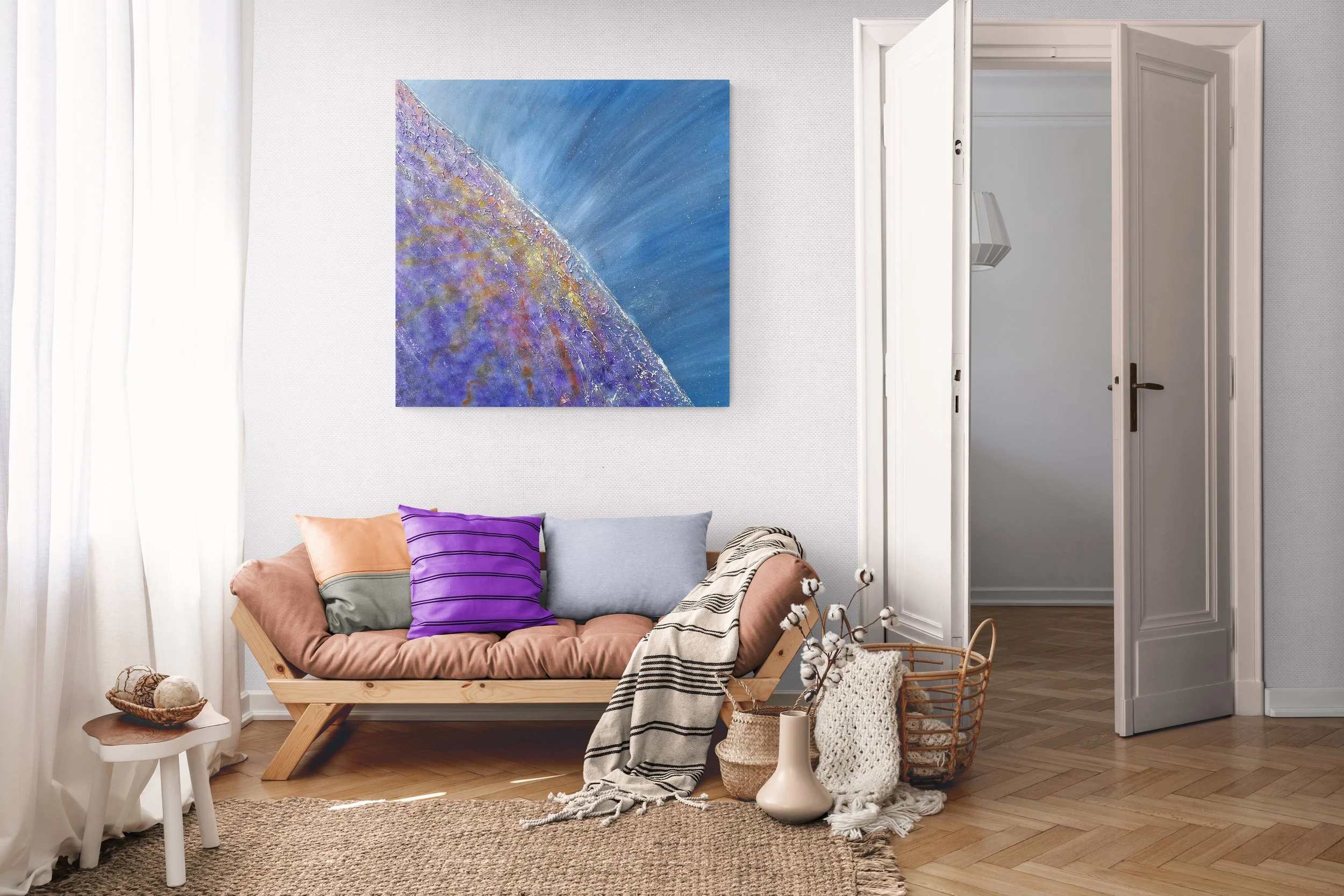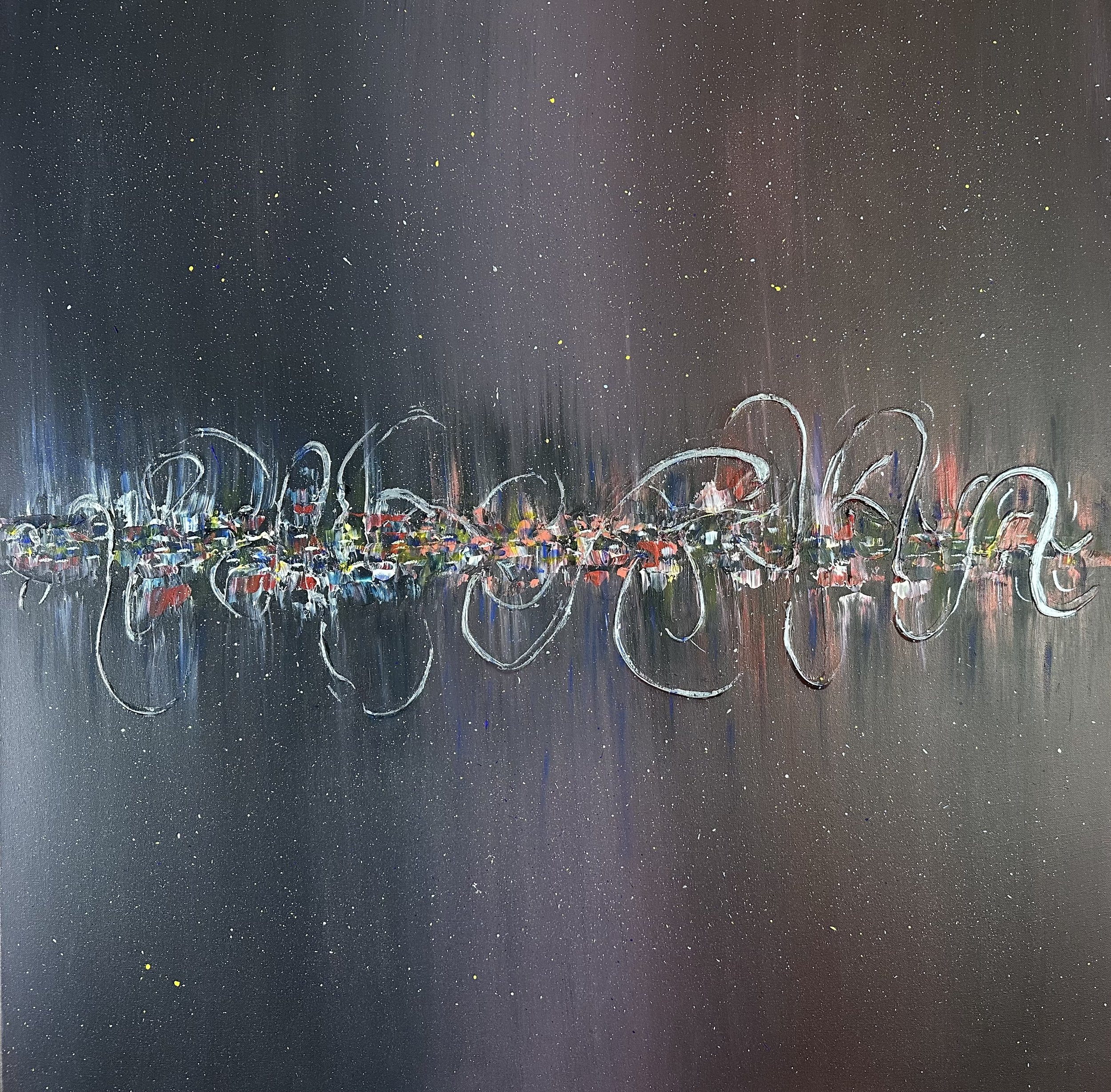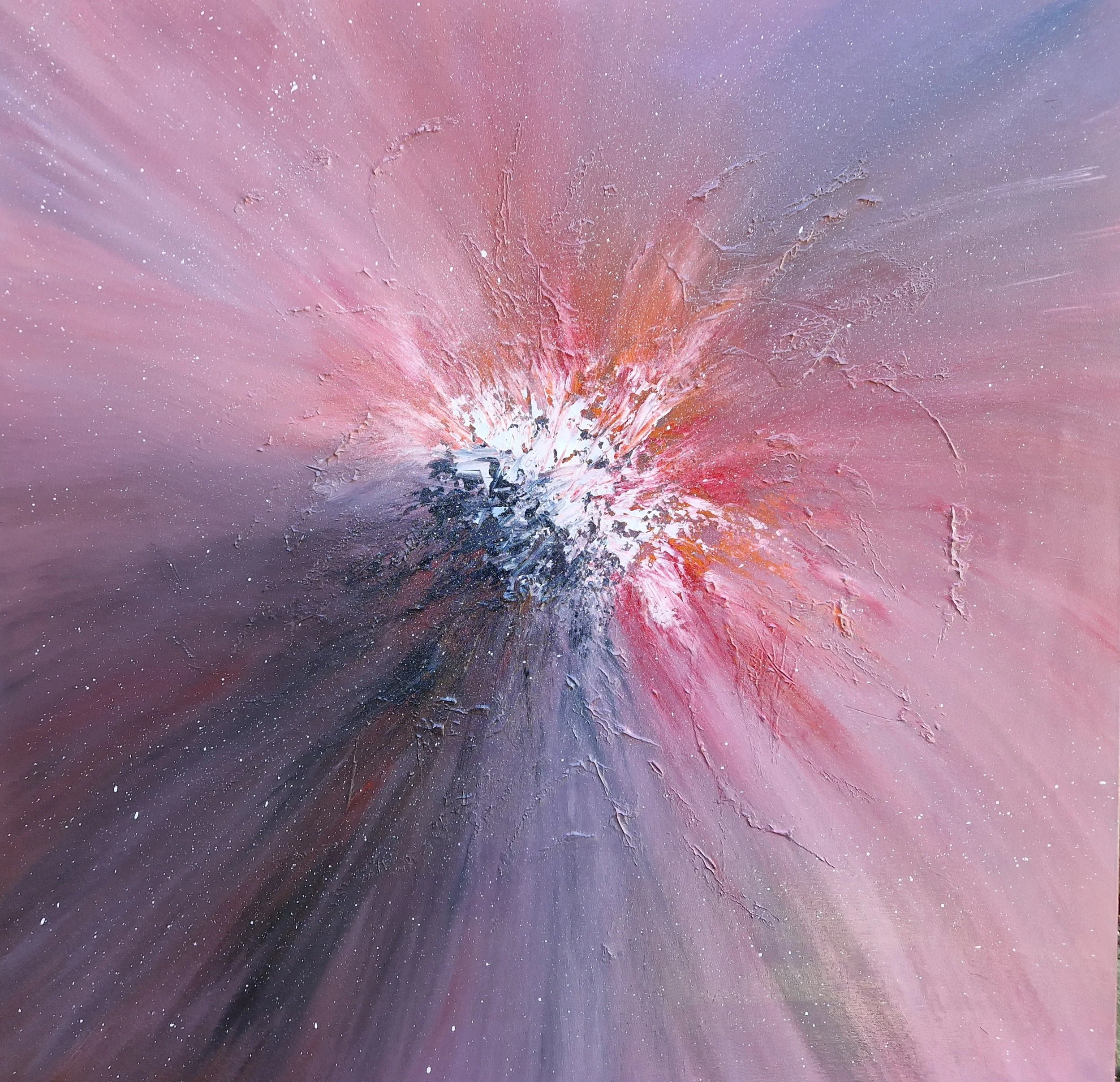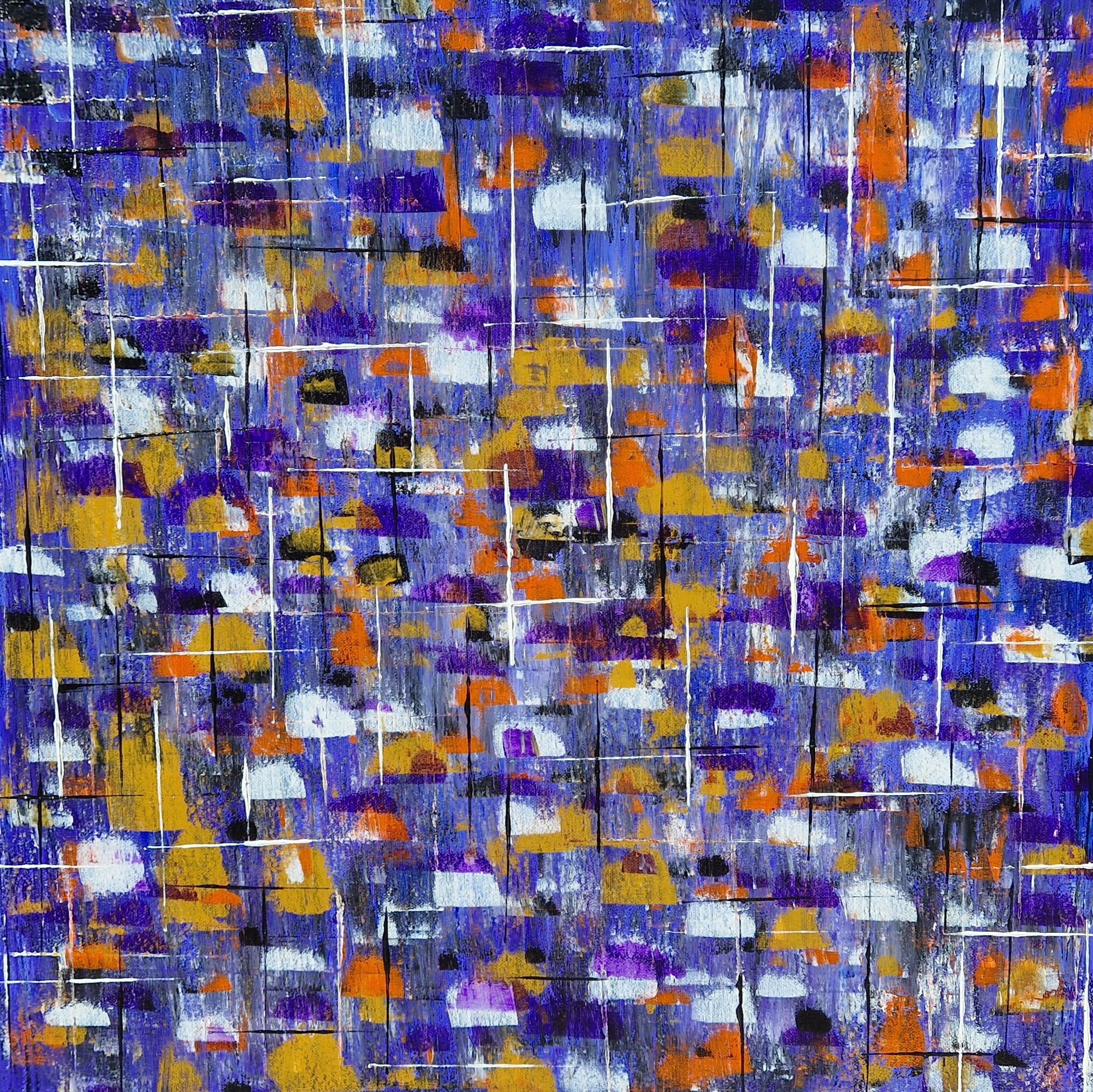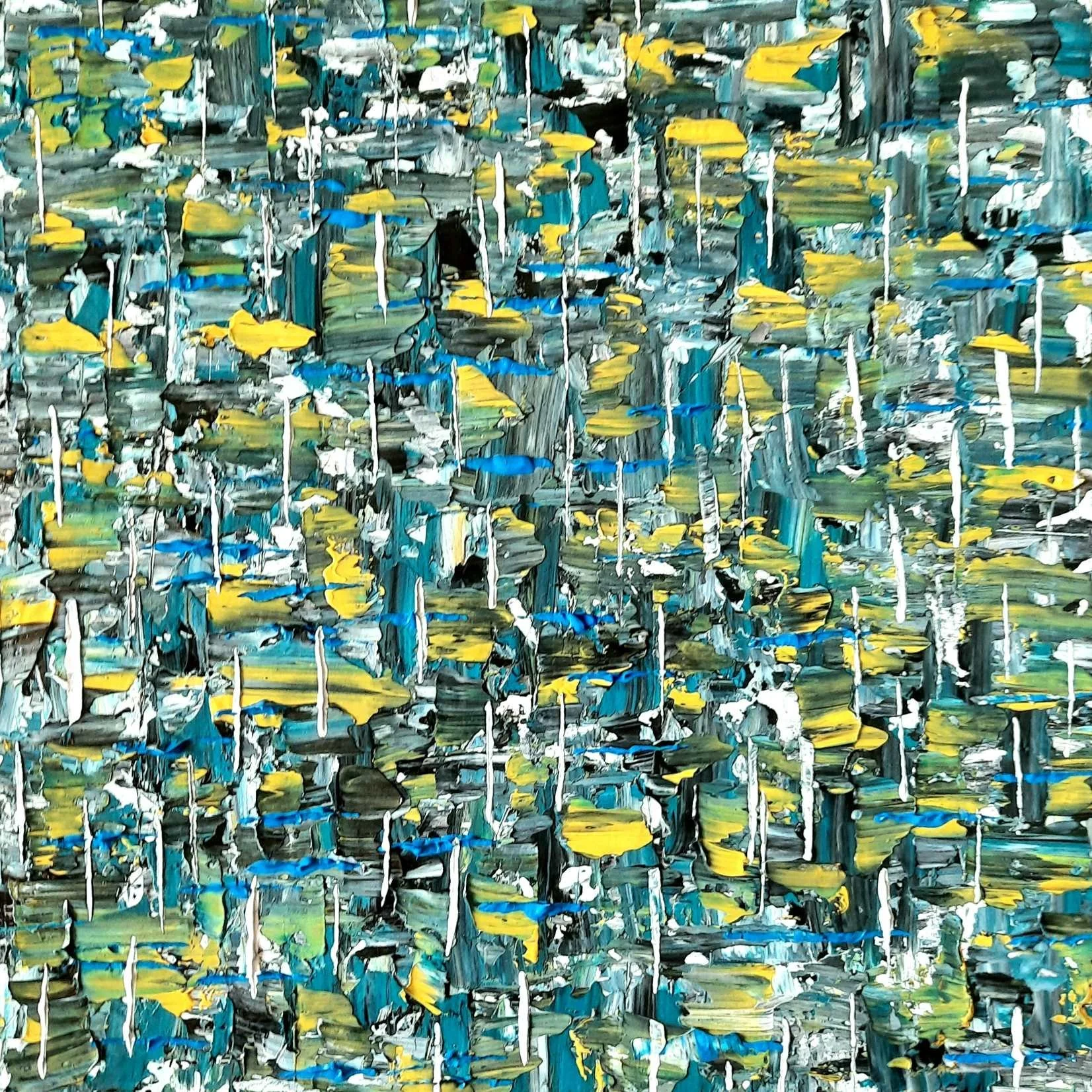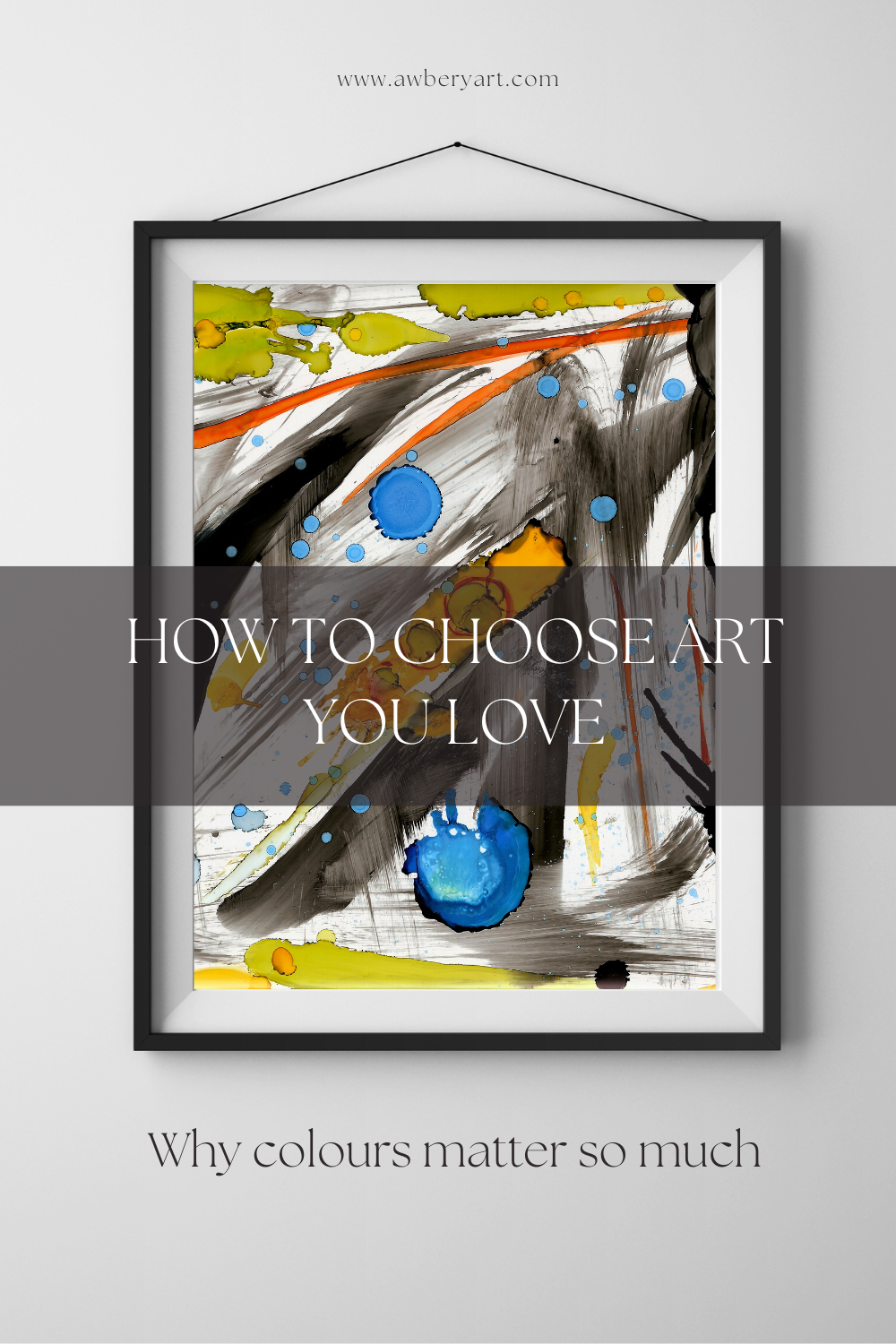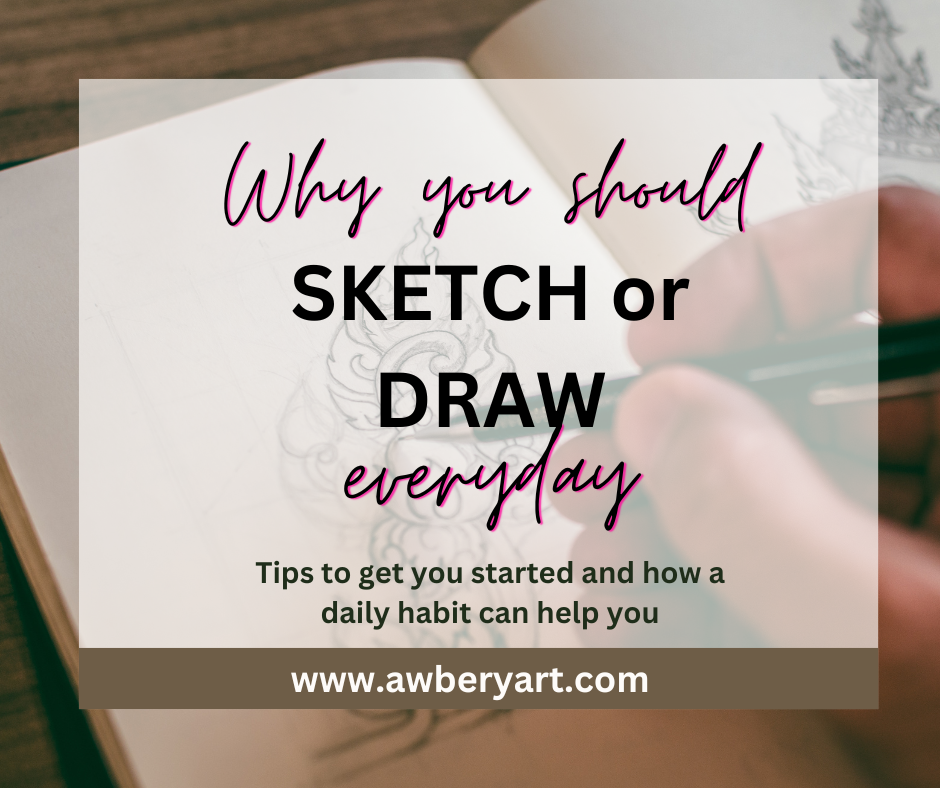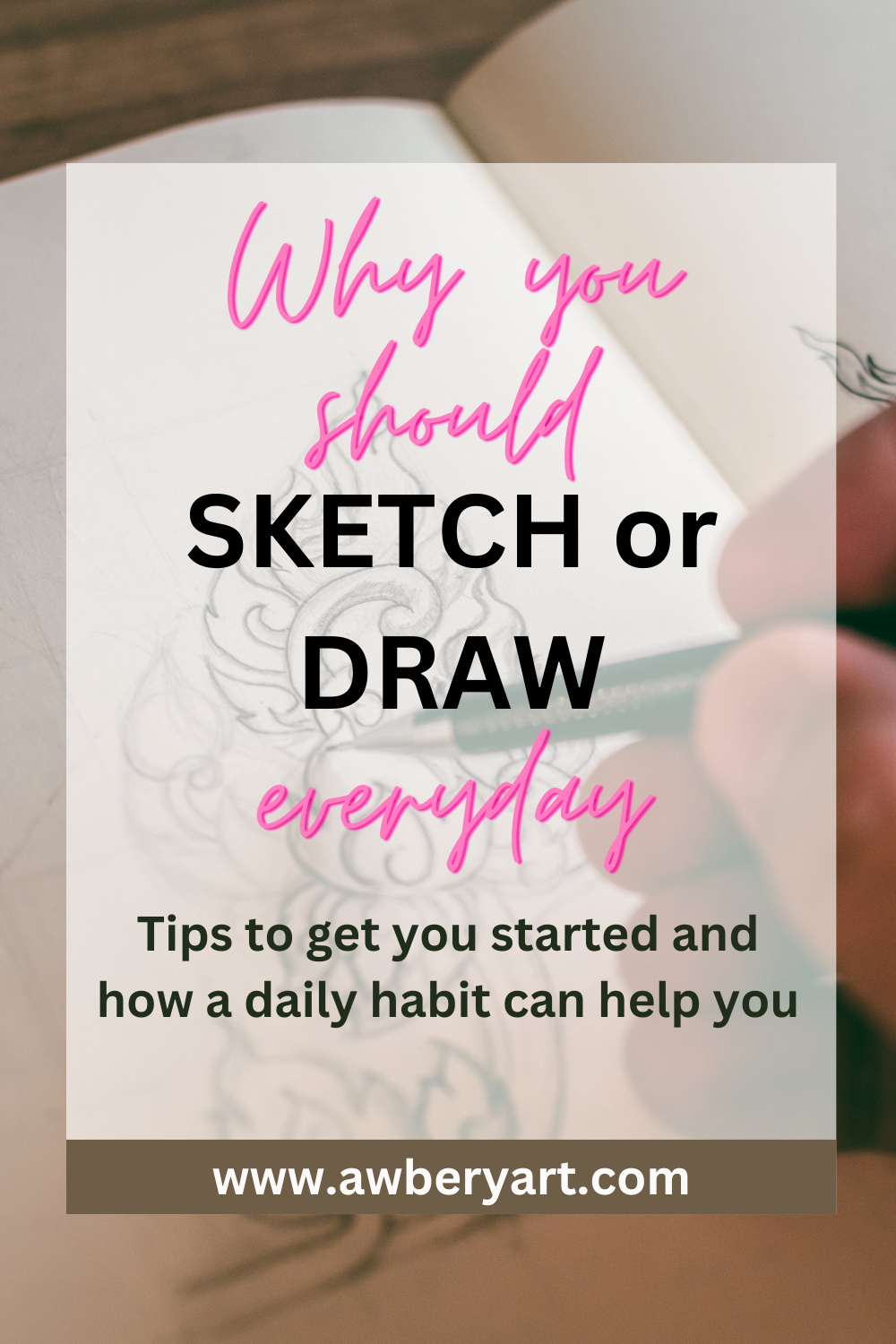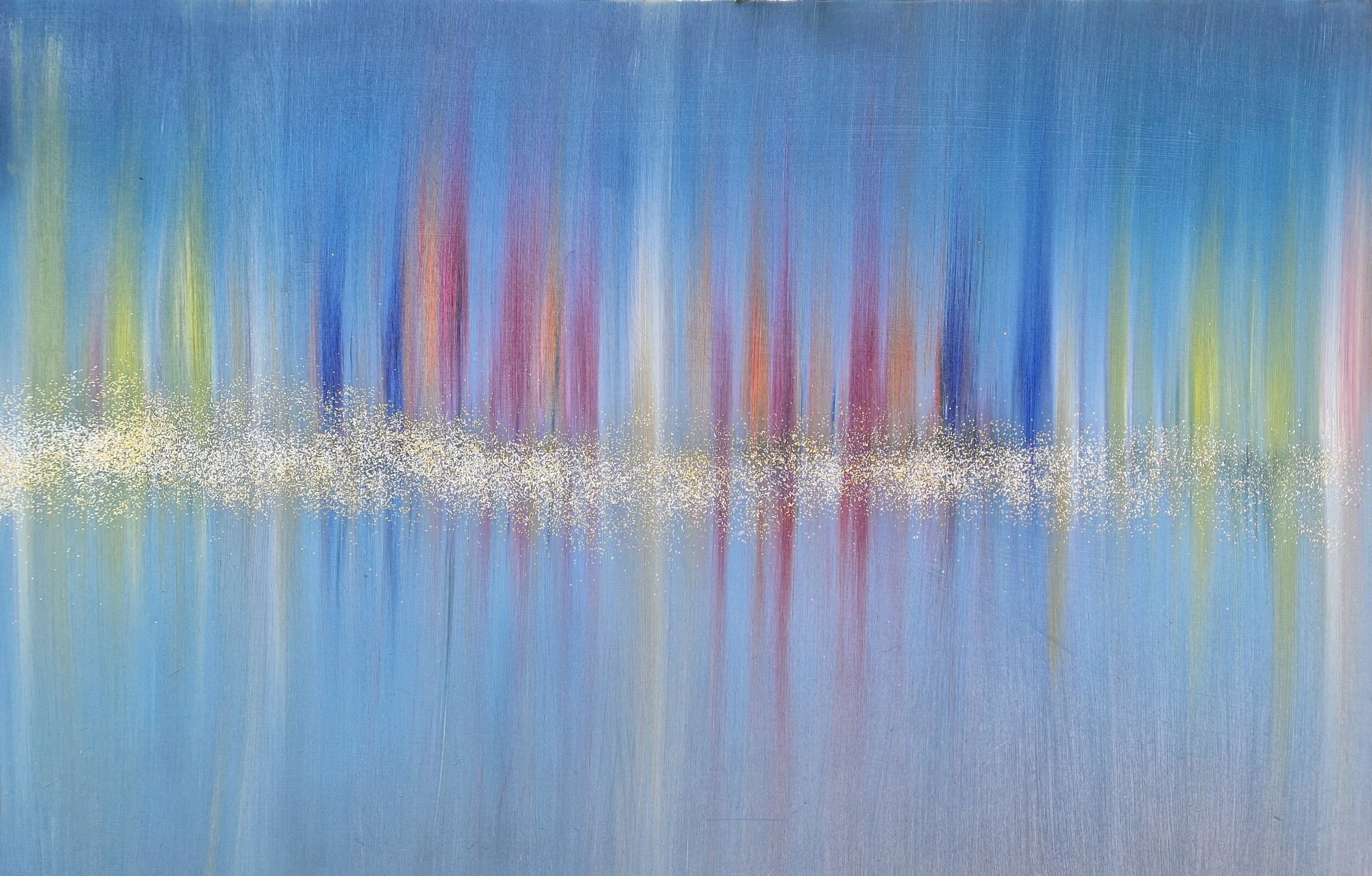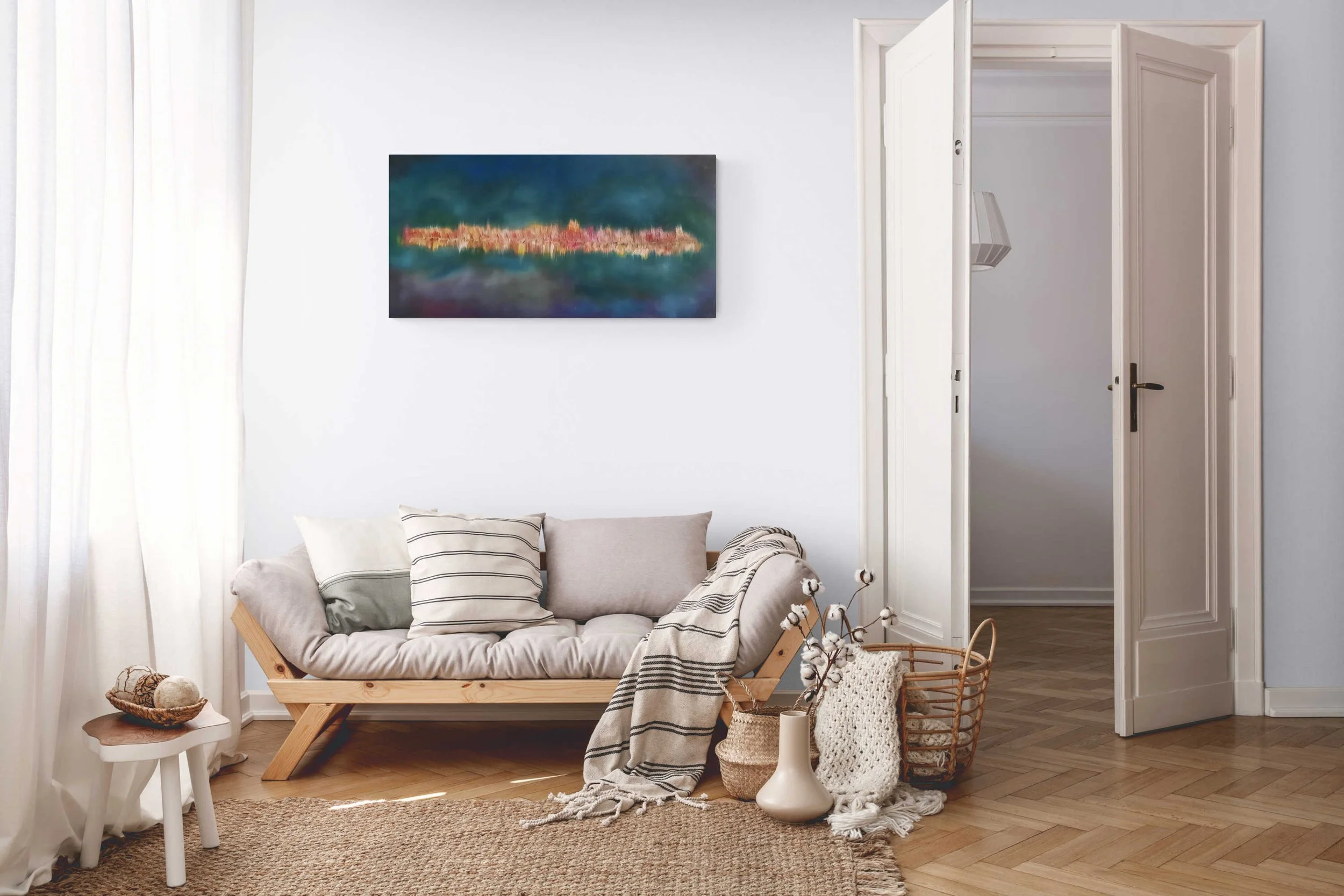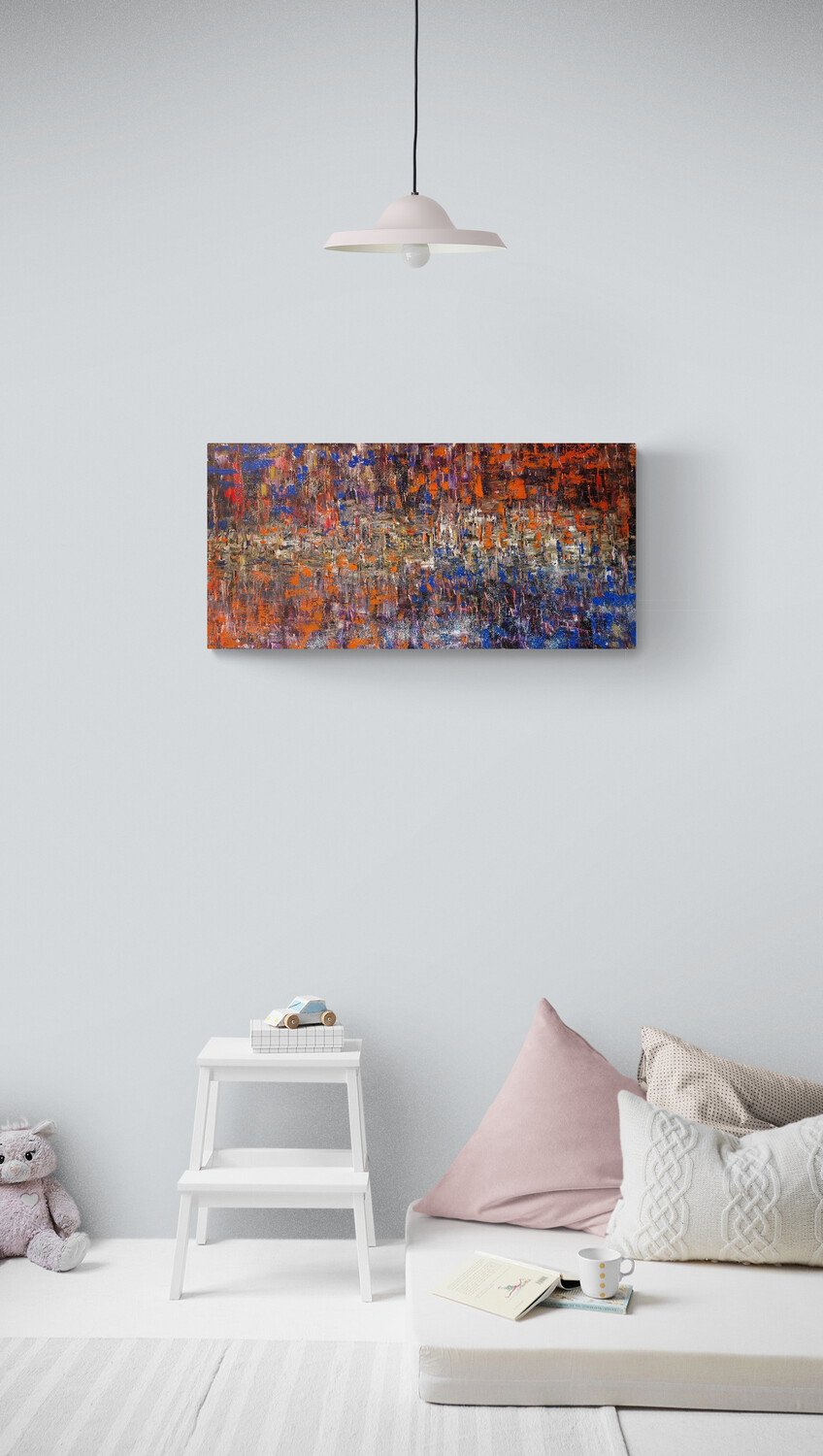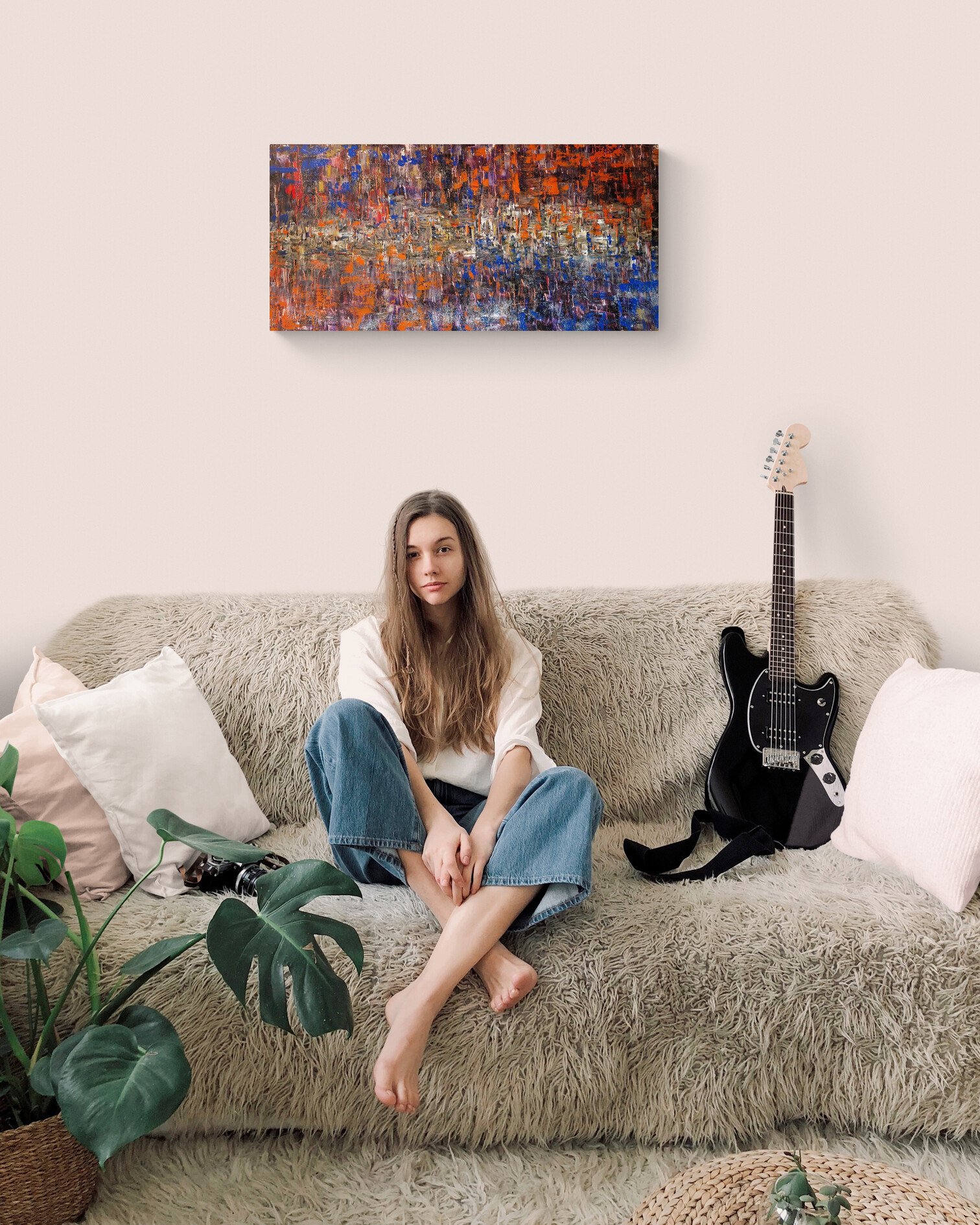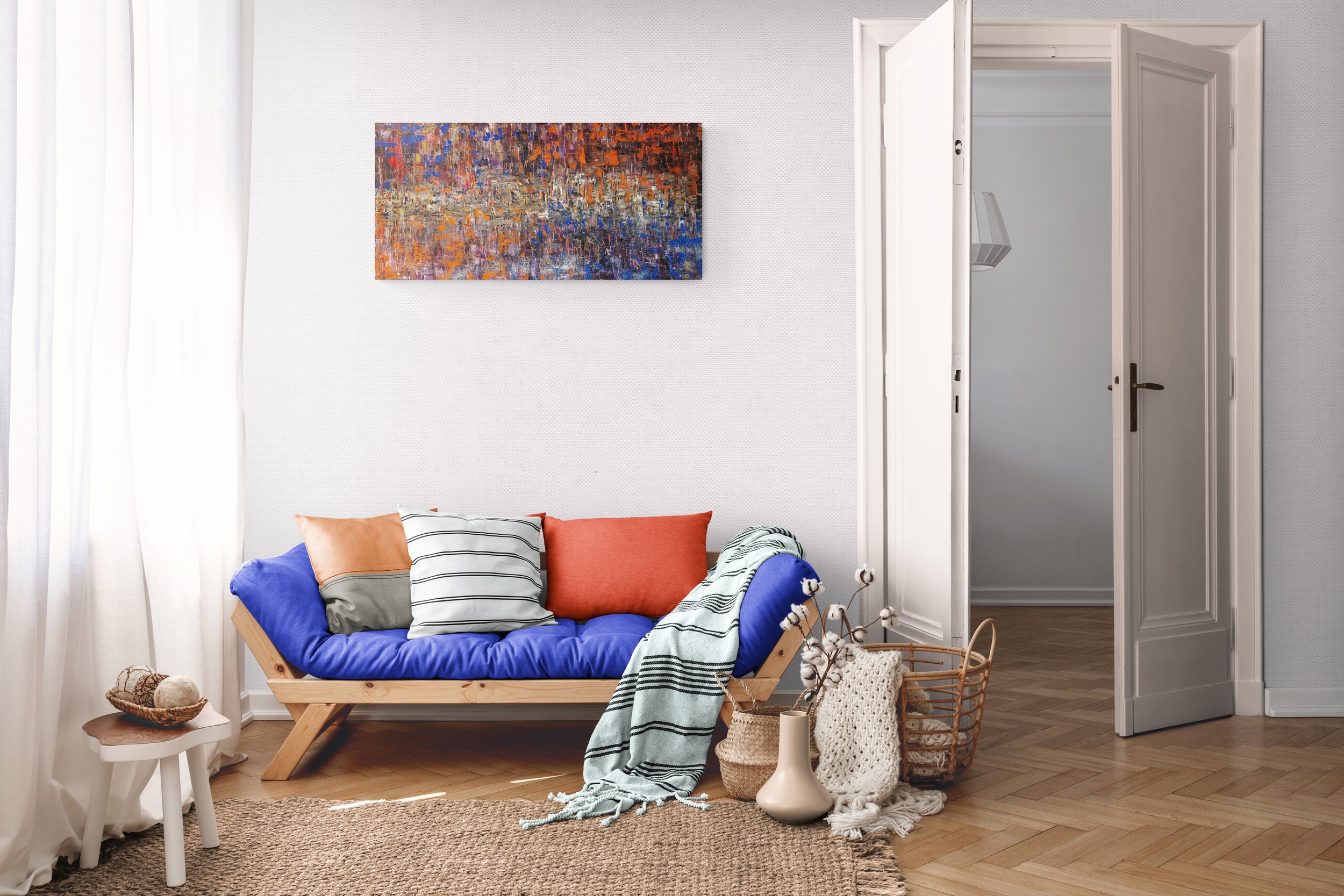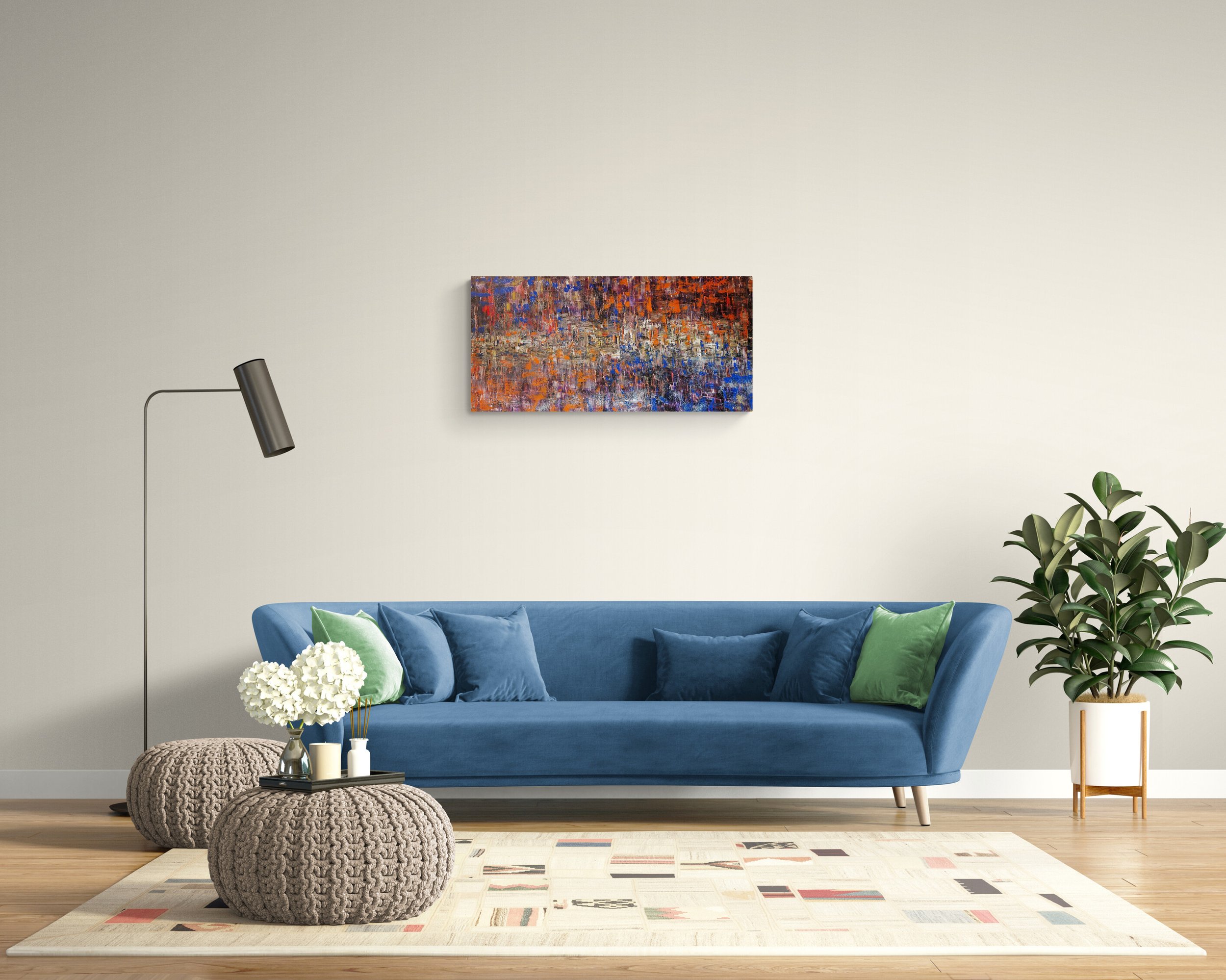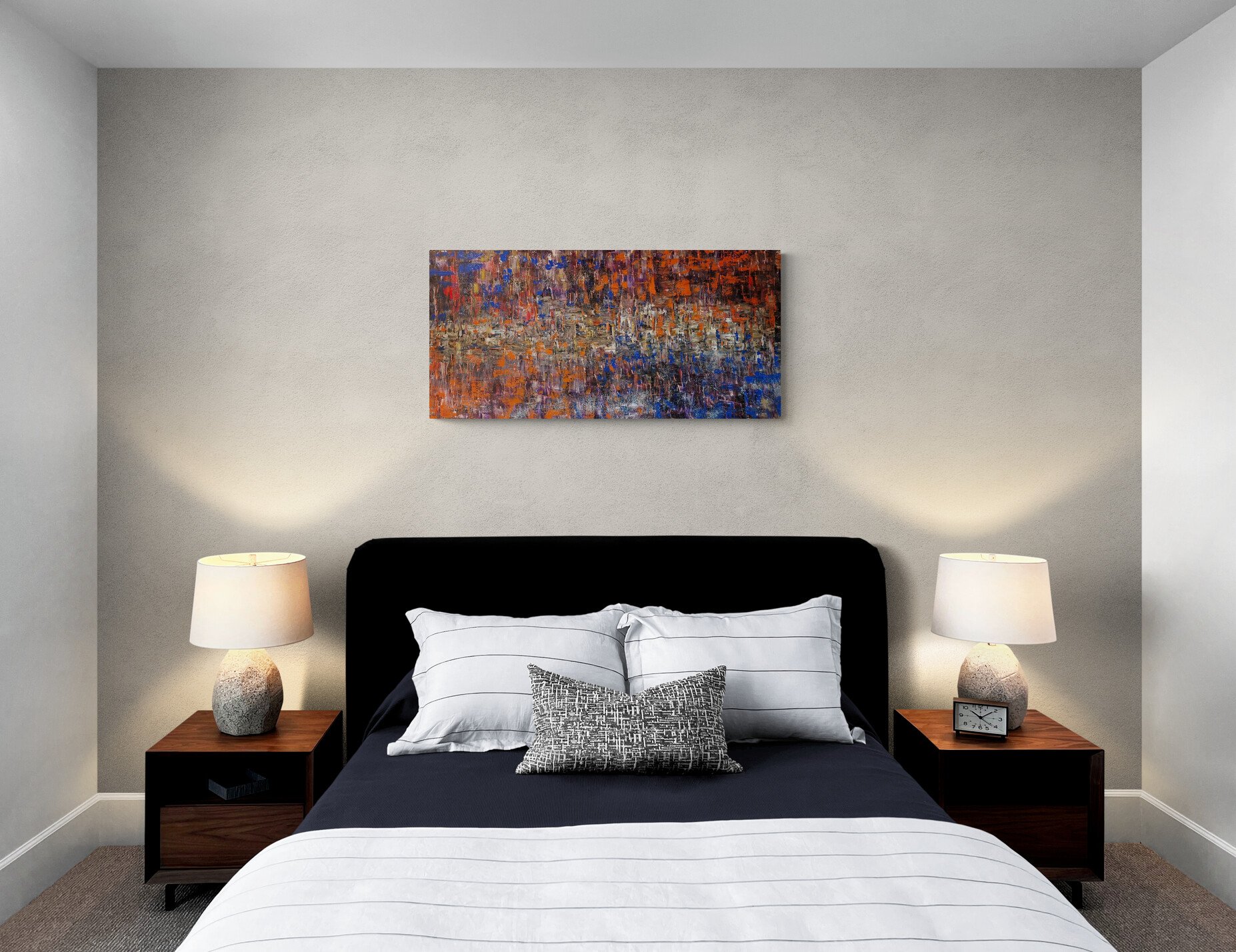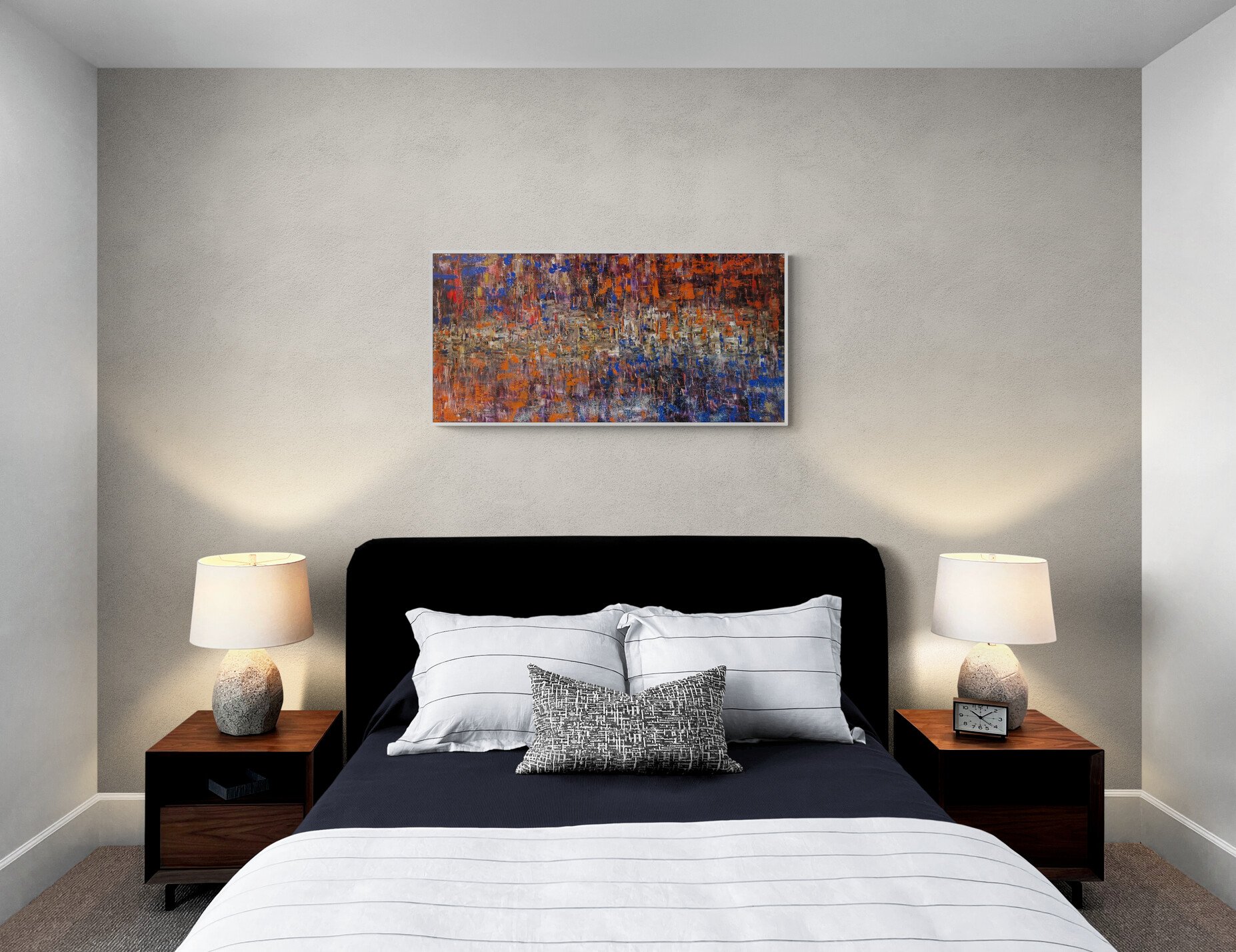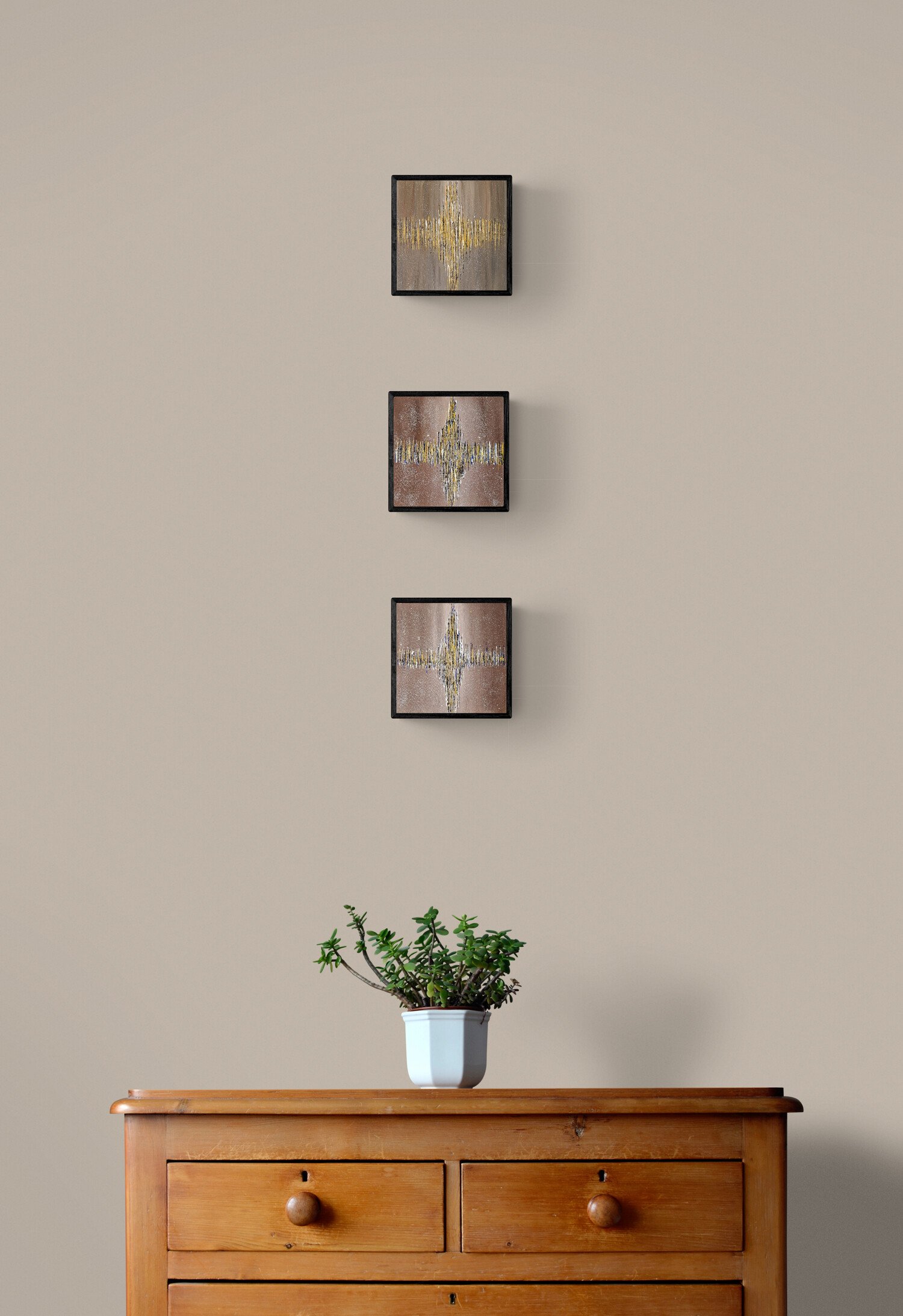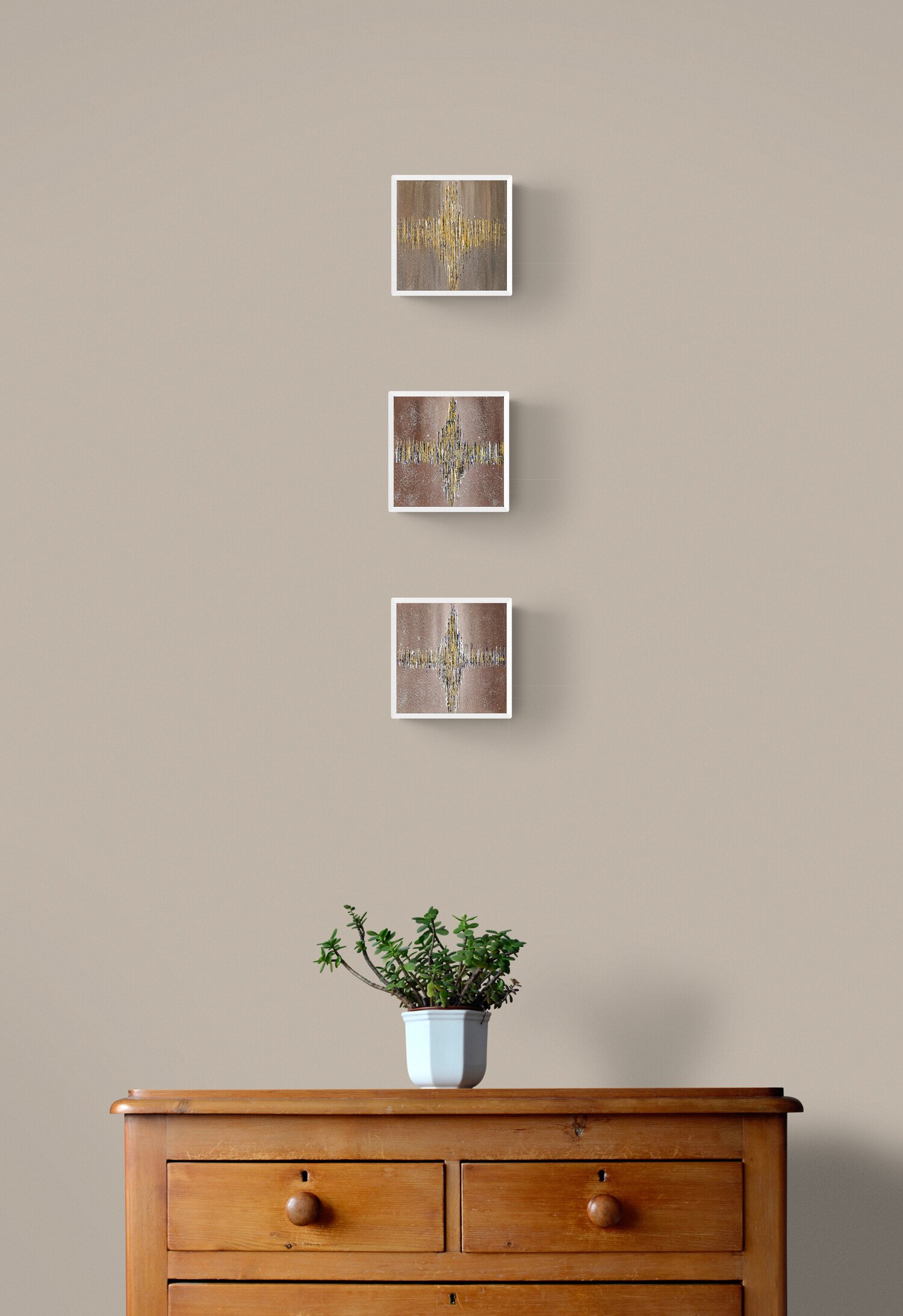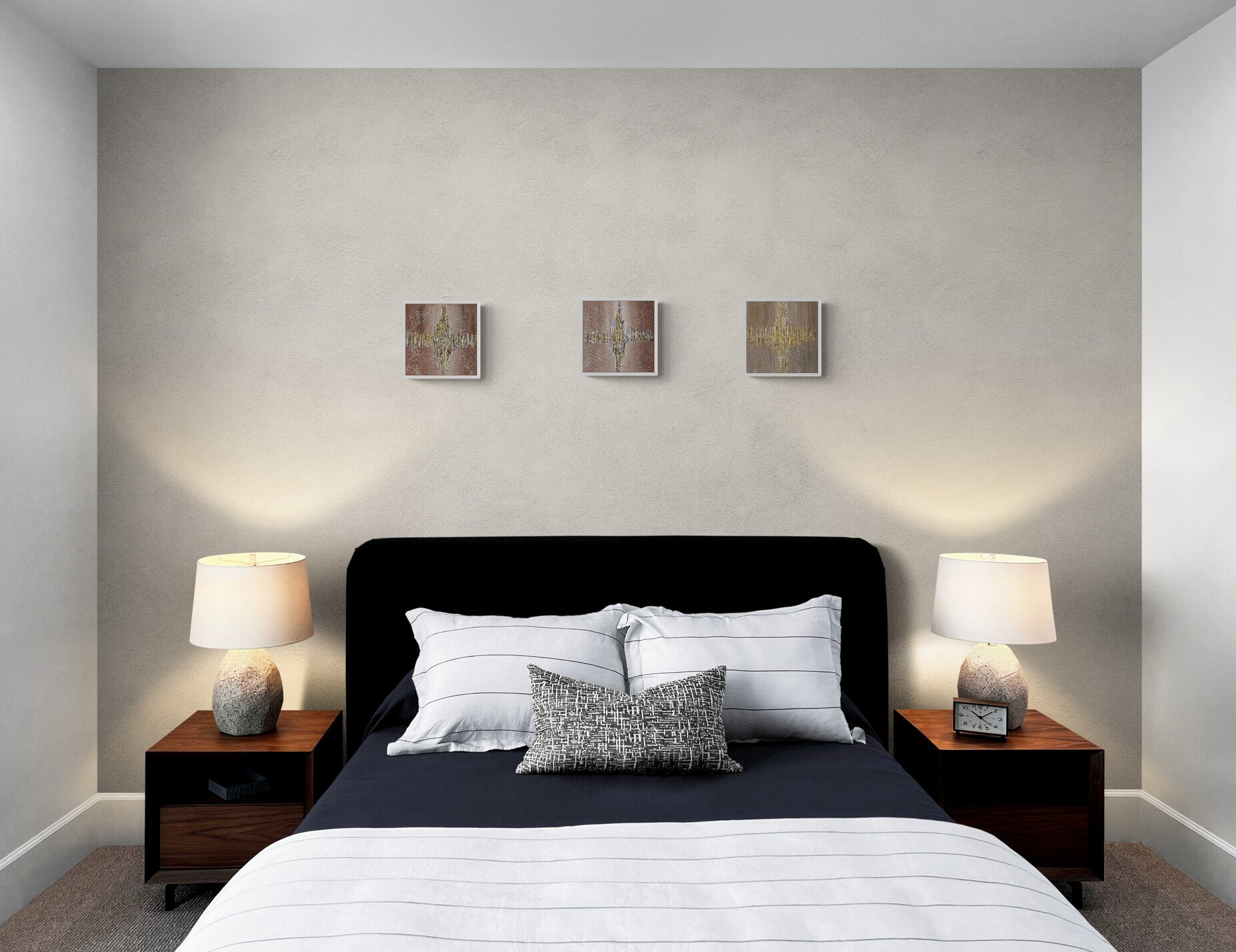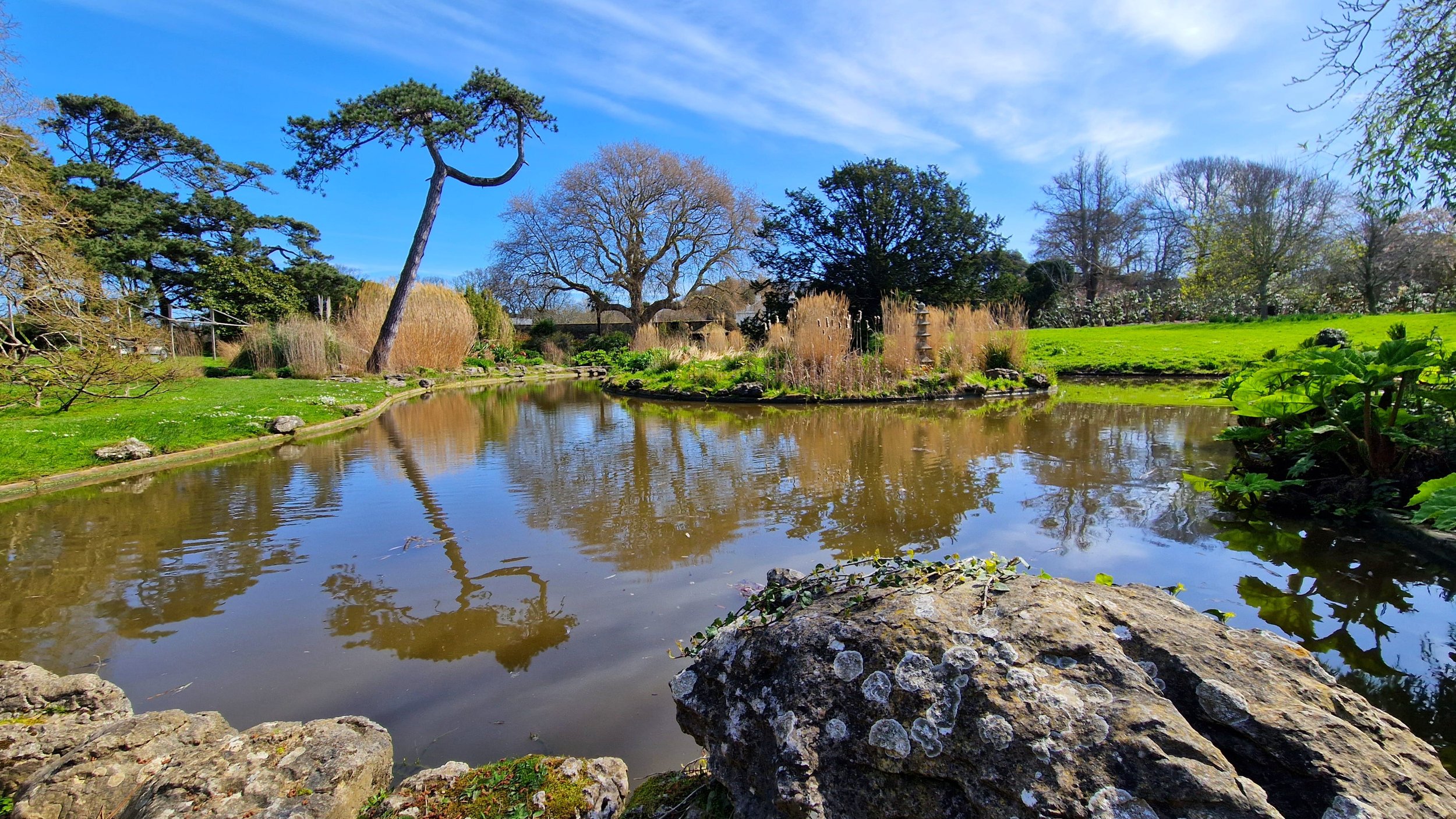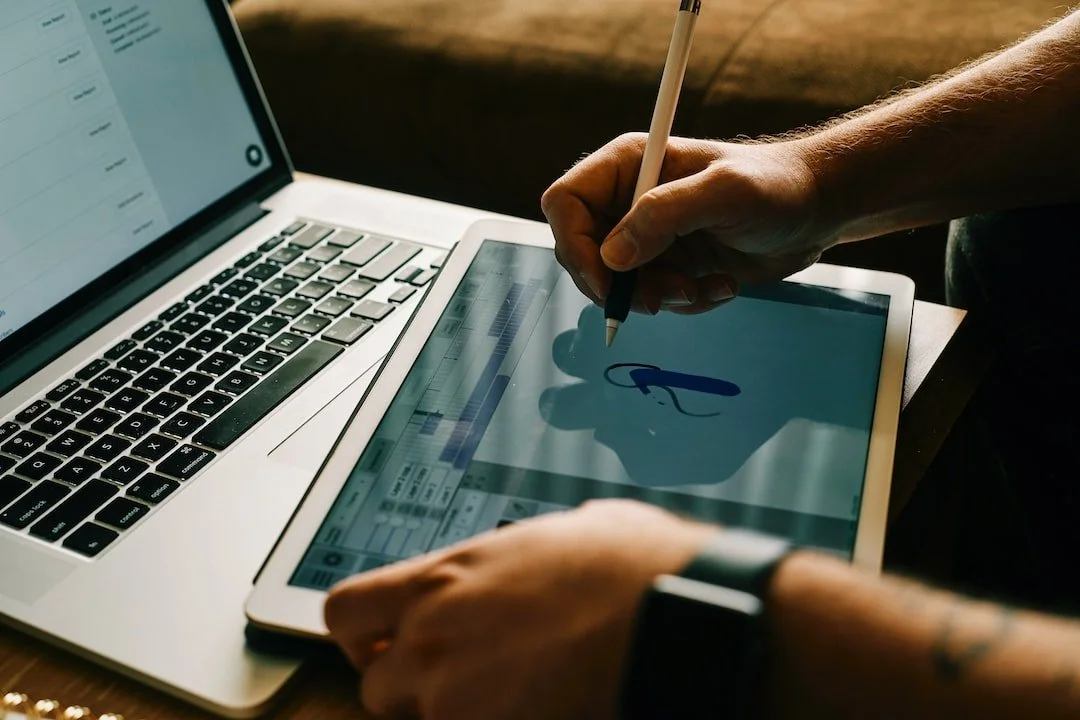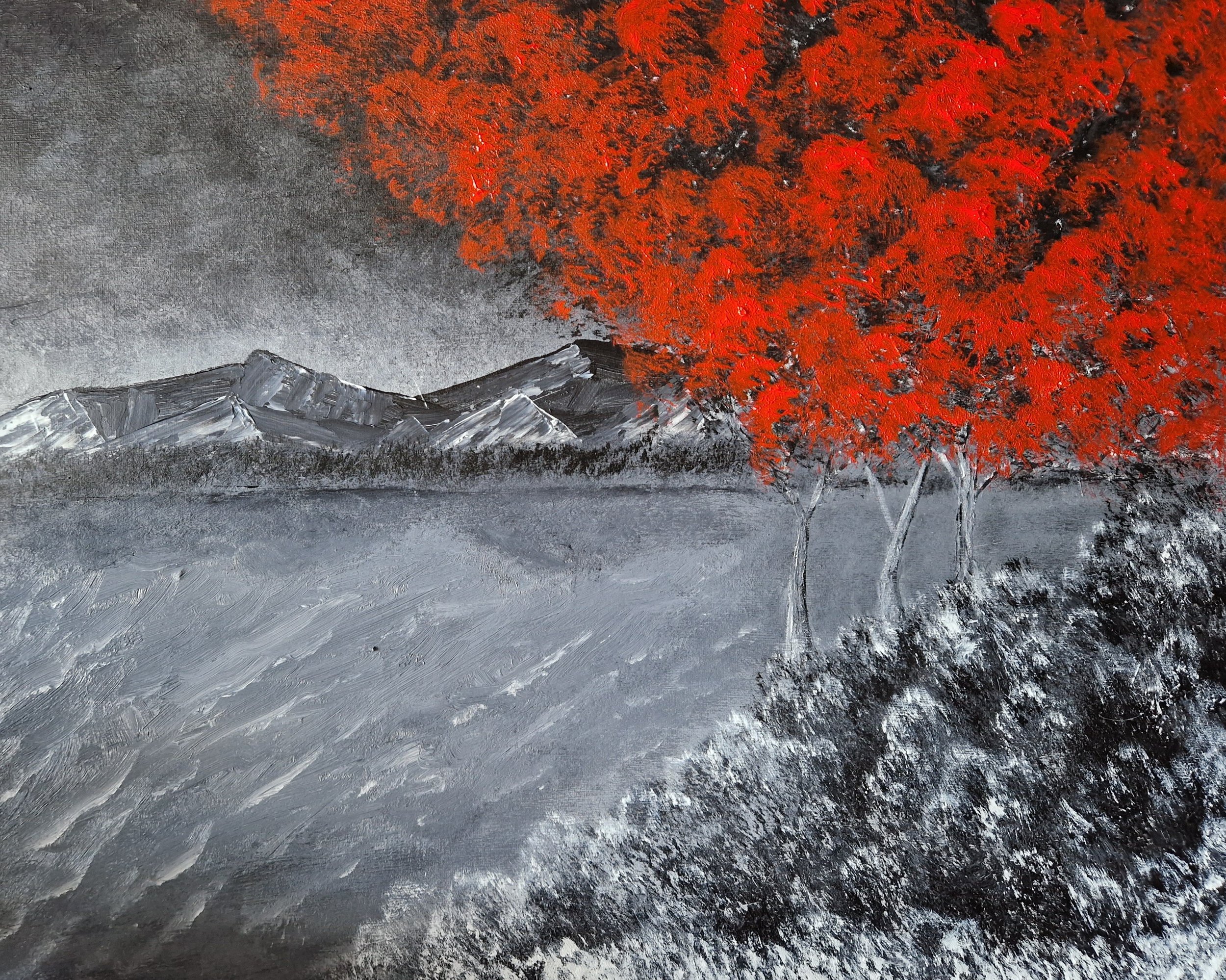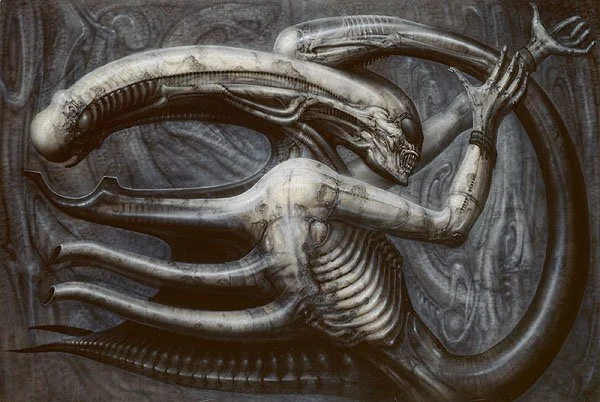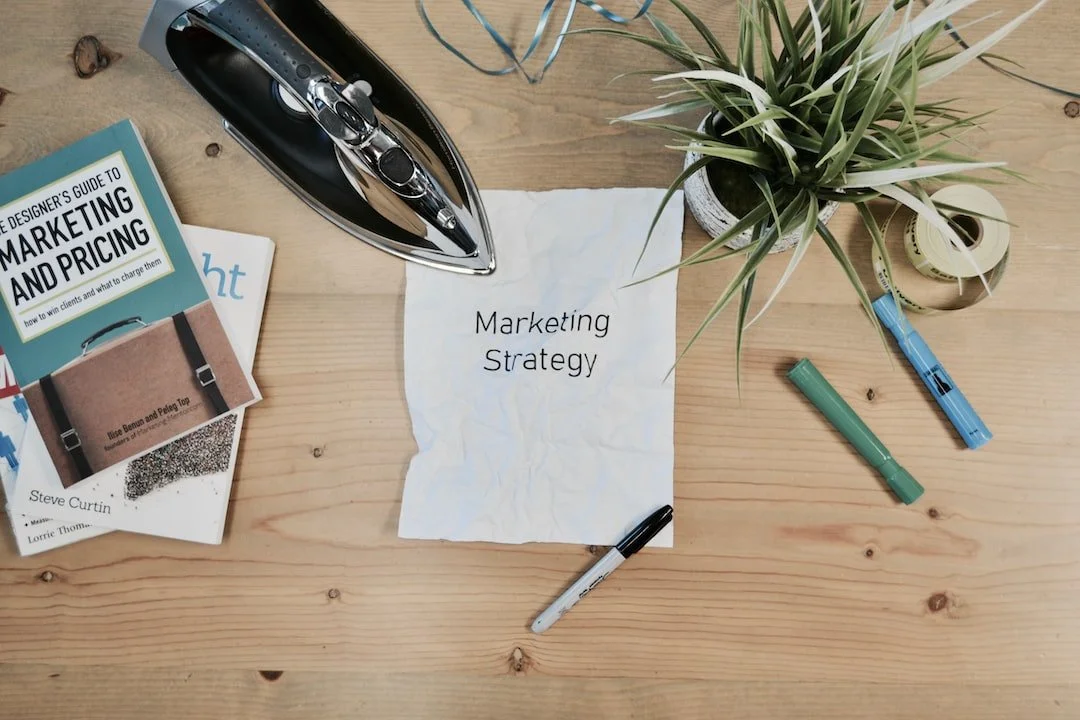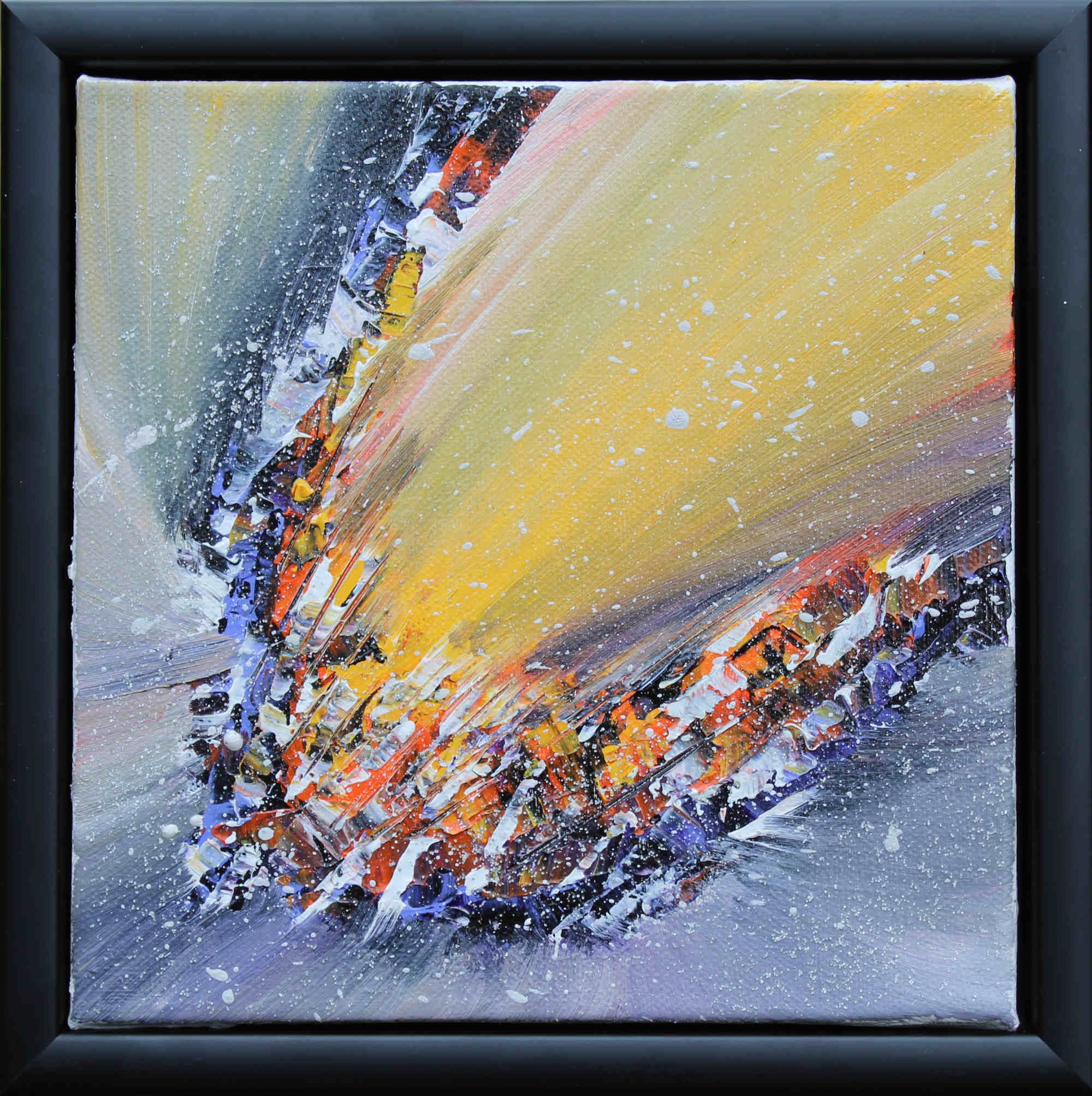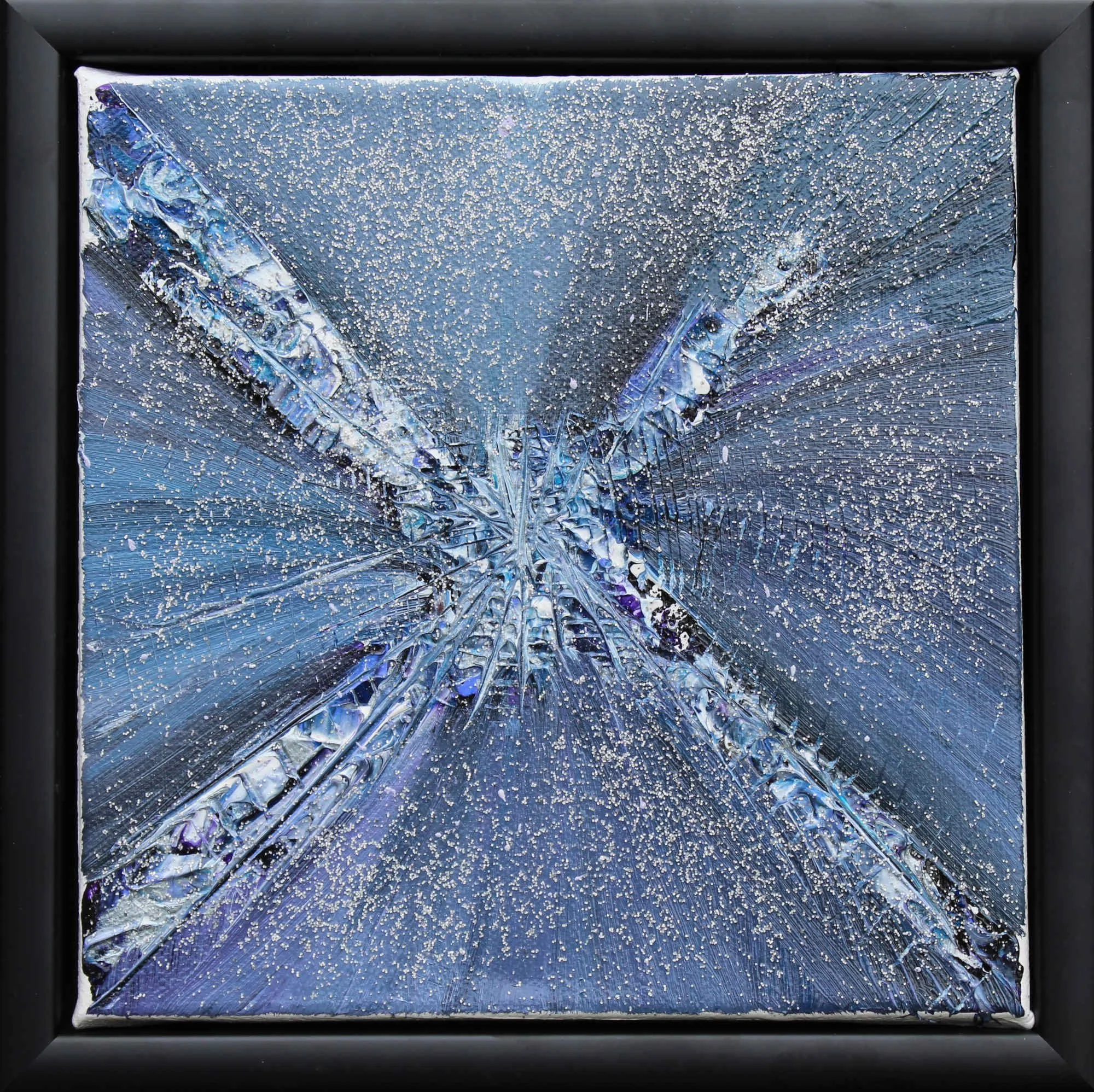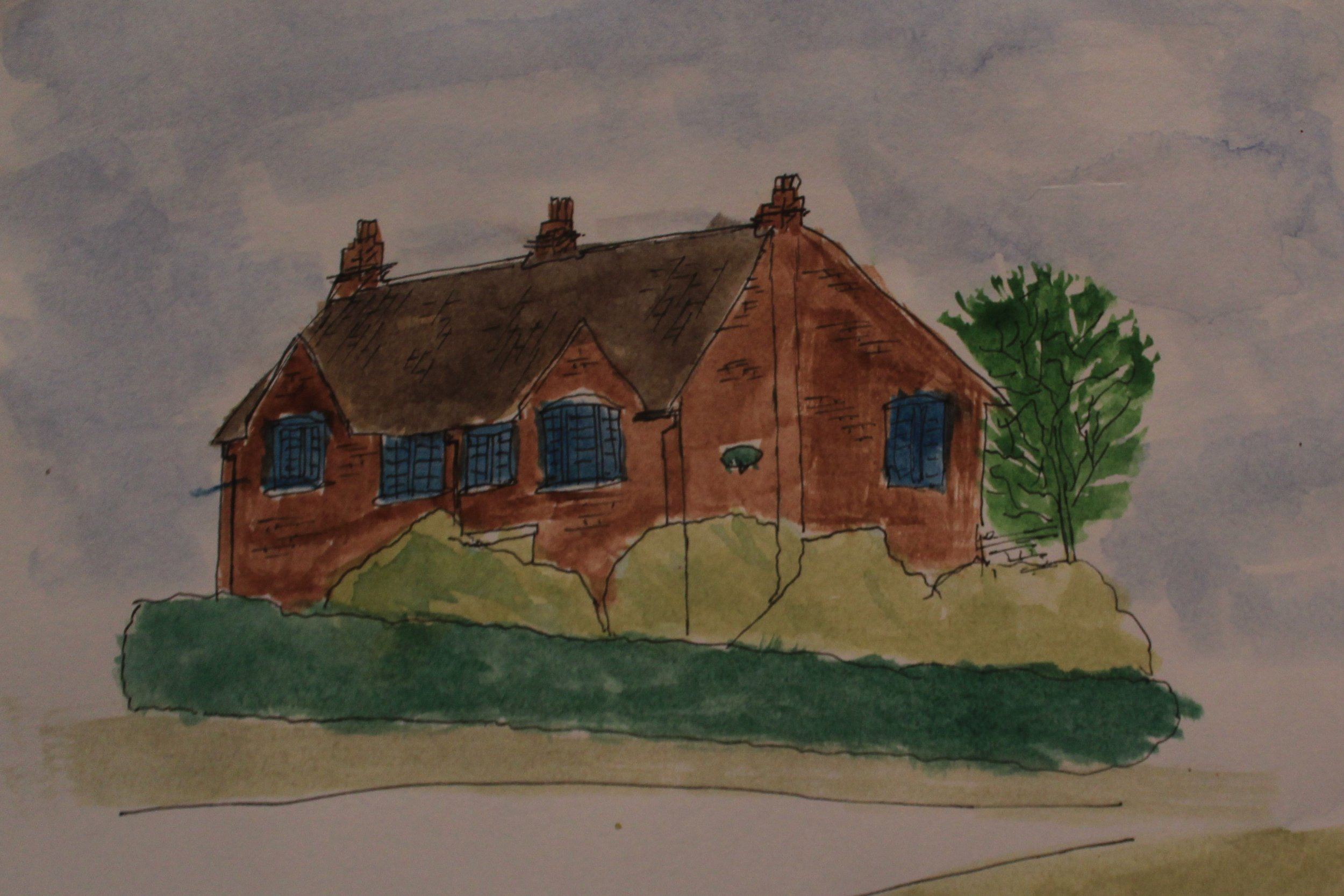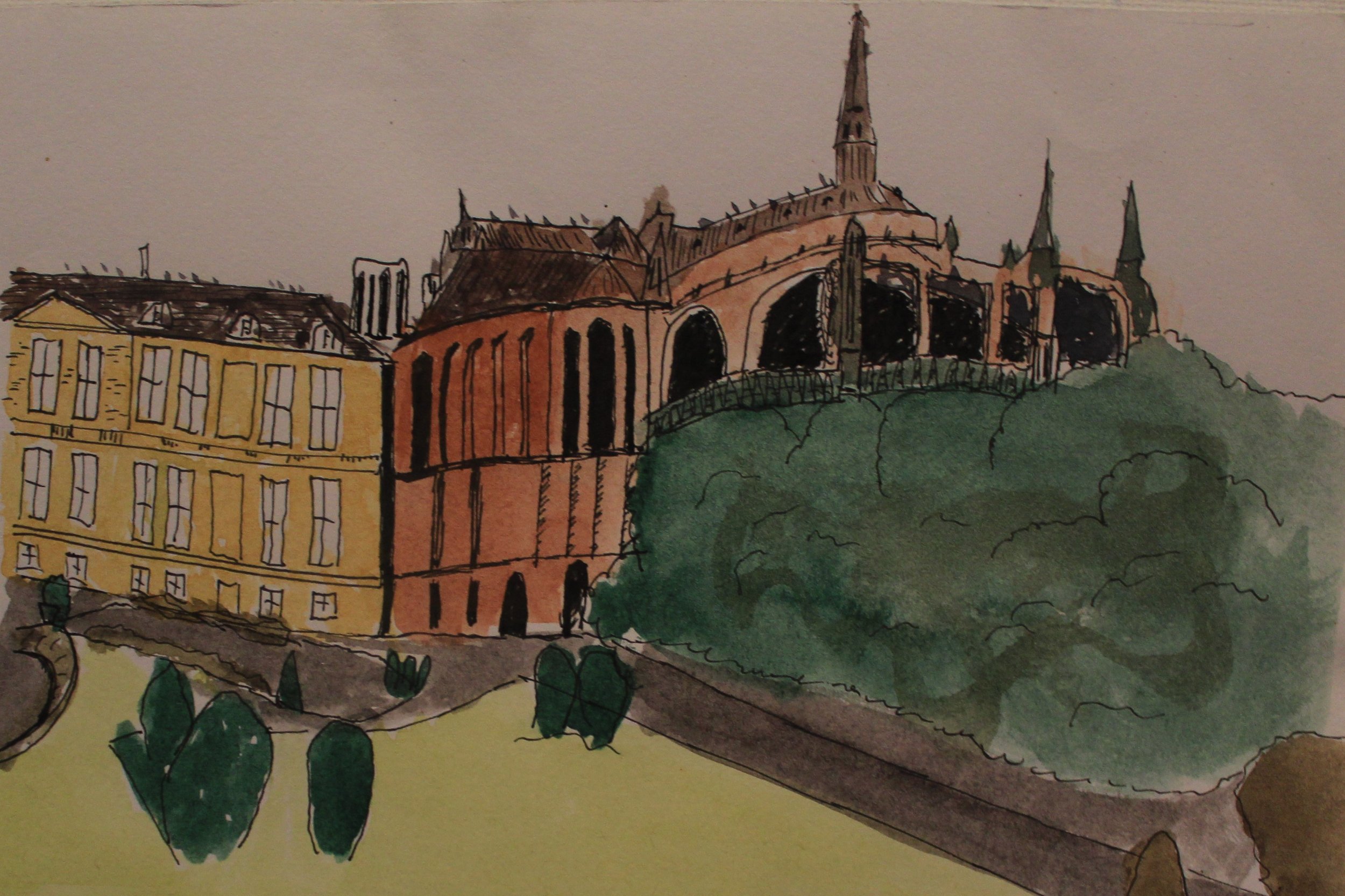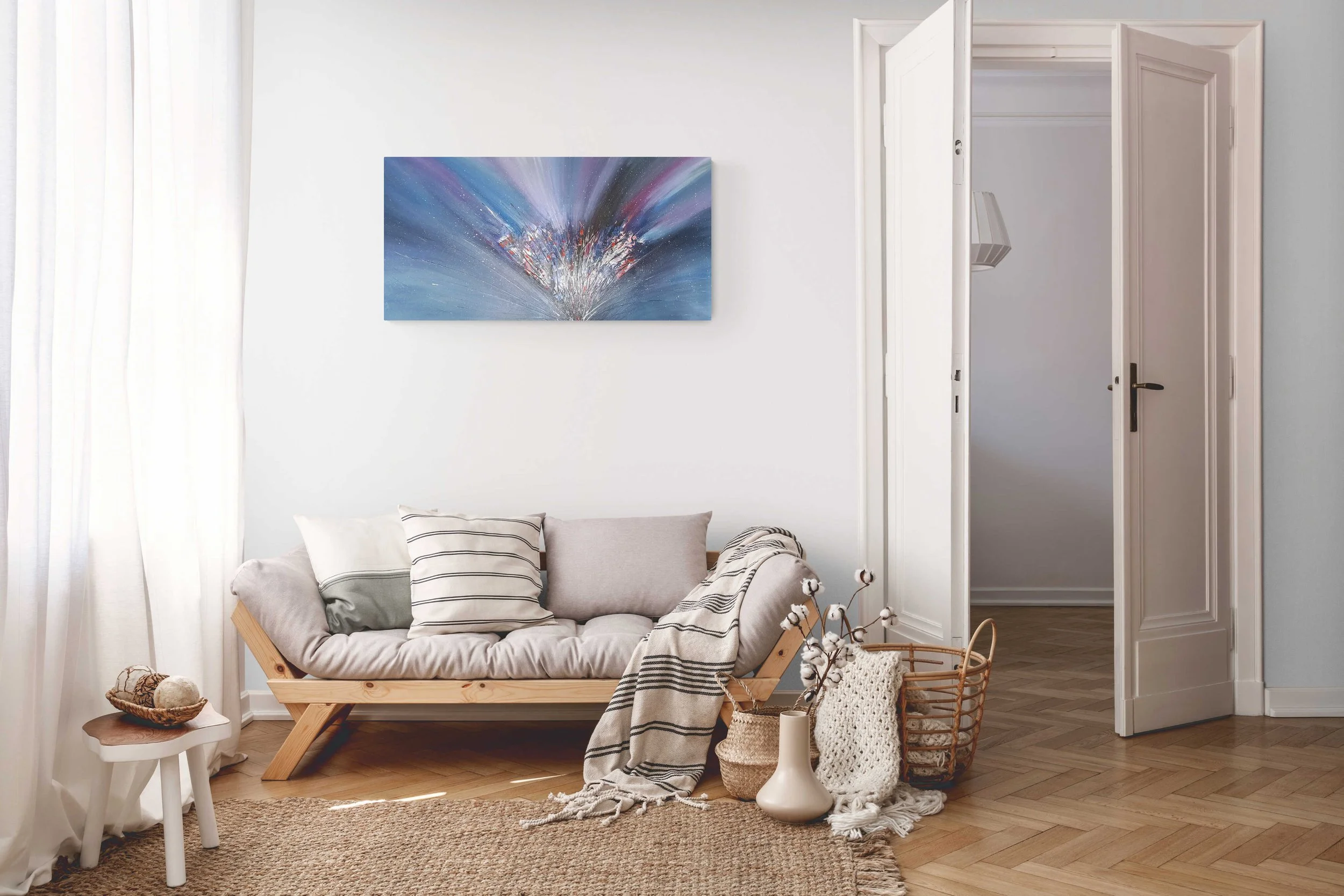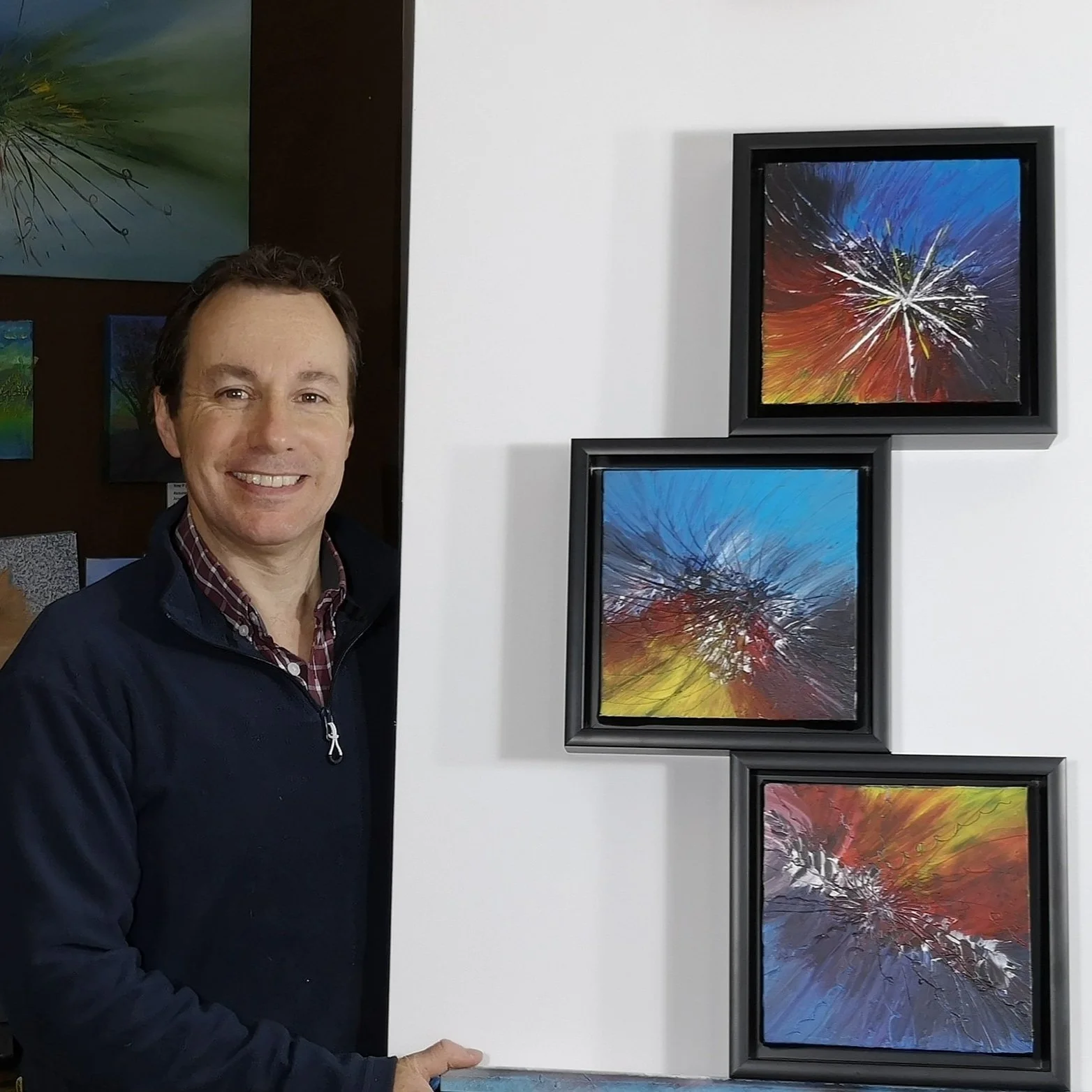Why Abstract Art is a Smart Investment for Collectors and Enthusiasts
Abstract art isn’t just about aesthetics—it’s an asset. Find out why high-end collectors and investors are turning to contemporary abstract pieces for both their beauty and long-term value.
Abstract art has long been a statement of sophistication and cultural insight, but did you know it can also be a smart investment? In my latest blog, I explore why collectors and investors alike are turning to high-end abstract pieces, how the market for contemporary art is evolving, and what makes a piece truly valuable over time. Whether you're a seasoned collector or just starting your journey into fine art, this article will help you see abstract works in a whole new light. Read the full article at www.royawbery.substack.com.
A Fresh Look & A New Chapter for My Art
Roy P. Awbery Fine Art in Berkshire has had a makeover. Focus is now on original high-end abstract art for discerning collectors and art lovers. You can read more in the full blog on Substack.
Big changes are happening! Following expert advice, I’ve refined my artistic focus and restructured my website to reflect my true passion—abstract art. My work has always found homes around the world, and with this shift, I’m embracing a more high-end, curated approach.
My new website reflects this evolution, showcasing a carefully selected collection of my best pieces. I’ve also adjusted my pricing to match the increasing demand, ensuring that my collectors are investing in artwork that continues to grow in value.
Read more about this exciting new chapter on my Substack blog!
Embracing Beauty: The Story Behind "Radiant Bloom"
Radiant Bloom - an original painting by Roy P. Awbery Fine Art. Available to buy now.
I'm excited to share with you the journey behind my latest creation, "Radiant Bloom." This acrylic masterpiece is a celebration of beauty, inspired by the captivating essence of blooming flowers and the vibrant colours they bring to life.
As an artist based in Berkshire, my passion for art has always been fueled by a desire to capture moments of wonder and inspiration. With "Radiant Bloom," I wanted to delve into the enchanting world of floral artistry, exploring how colours, shapes, and textures can evoke emotions and tell stories.
The central theme of "Radiant Bloom" is the burst of vibrant colours, predominantly pink, stretching across the canvas. This burst symbolizes the beauty and energy of blooming flowers, radiating joy and vitality. As you gaze upon the painting, imagine the delicate petals unfurling, the intricate veins that hint at nature's meticulous craftsmanship.
For me, creating "Radiant Bloom" was not just about painting a canvas; it was about capturing a moment of awe and sharing it with others. Art has the power to uplift, inspire, and transform, and I hope that "Radiant Bloom" does just that for you.
As you explore this newsletter, I invite you to immerse yourself in the world of artistry and beauty. Let "Radiant Bloom" be a reminder of the magic that surrounds us and the endless possibilities of creative expression.
Thank you for being a part of this journey. Let's continue to embrace beauty, creativity, and inspiration together.
Warm regards,
Roy P. Awbery
Goodbye 'Urban Rhythm' and Community Impact
The story behind my abstract painting, Urban Rhythm.
Welcome back to another edition of my newsletter (yes, like buses you two in quick succession!), where I share insights, stories, and updates from my artistic journey.
Saying Goodbye to Urban Rhythm
This vibrant and dynamic painting called Urban Rhythm has now been shipped off to its new home on the Channel Island of Jersey. I am quite sure it will look amazing when it is finally installed in its new home and I hope the lucky recipient is as happy with it as I was after creating it.
"Urban Rhythm" is not just a painting; it's a reflection of the pulsating rhythm, movement, and vitality found in urban landscapes. Each brushstroke tells a story of creativity and expression, inviting viewers to delve deeper into the layers of colour and emotion.
I hope that, whether you're an art enthusiast, collector, or interior designer, Urban Rhythm stirs something in you and it certainly promises to inspire and ignite conversation.
But that's not all! After a successful day a the Burghfield May Fayre, where more of my artwork sold, I now have the time to think of the artwork I plan on displaying at a cafe in Newbury, Berkshire.
All being well, I hope to have some of my works on display at McCann’s Cafe in the Kennet Centre, Newbury. What makes this collaboration truly special is that a generous portion of the profits from art sales will support Max's 'pay-it-forward' initiative. This initiative helps those in need by providing meals and coffee to those less fortunate—a cause that aligns perfectly with my belief in using art to make a positive impact in our community.
Stay Connected and Explore More
For more updates on my artwork, upcoming exhibitions, and creative insights, be sure to follow me on social media and subscribe to my newsletter. Visit my website at www.awberyart.com to browse through my portfolio and discover a world of artistic expression.
Thank you for being a part of this journey with me. Together, let's continue to celebrate art, inspire creativity, and make a difference in the world around us.
Warm regards,
Roy P. Awbery
Brushing Away Boundaries: The Joy of Daily Painting
If you're ready to embark on a life-changing journey into daily painting, exploring the realms of watercolours, acrylics, and oils, you're in for a treat. Join me as we delve into the magic that continuous practice, diverse learning, and a touch of style evolution can bring to your artistic endeavours.
If you're ready to embark on a life-changing journey into daily painting, exploring the realms of watercolours, acrylics, and oils, you're in for a treat. Join me as we delve into the magic that continuous practice, diverse learning, and a touch of style evolution can bring to your artistic endeavours.
Embracing the 30-Day Challenge: A Habit That Ignited My Artistic Flame
Five years ago, I set out on a 30-day painting challenge as a personal experiment, which became my artistic journey's cornerstone. To start your own challenge, pick a theme or go with the flow. Each day is an opportunity to experiment with different mediums, subjects, and styles. Don't overthink it—just let the brush guide you.
Continuous Practice: The Key to Mastery
Daily painting is a commitment to improvement. To enhance your skills, dedicate time each day to practice specific techniques. For watercolours, focus on mastering wet-on-wet or wet-on-dry techniques. With acrylics, experiment with layering and texture. In oils, explore the richness of blending and impasto. Platforms like YouTube offer valuable tutorials; for instance, Bob Ross's acrylic painting techniques are timeless.
Daily painting is not just a routine; it's a symphony of improvement, a journey where every brushstroke adds a note to your artistic composition. Here's how you can make the most of continuous practice:
1. Focused Skill Development:
Dedicate specific days to focus on honing particular skills. For instance, if you're working with watercolours, one day could be dedicated to perfecting the art of blending, while another focuses on creating textures. Experiment with different brush sizes and water-to-paint ratios to understand how they affect your watercolour outcomes.
2. Themed Exploration:
Explore themes during your daily practice sessions. This not only keeps your painting routine interesting but also allows you to delve into different genres and styles. Choose a week where each day is dedicated to a specific theme, like nature, emotions, or abstract concepts.
3. Challenge Yourself:
Push your boundaries by introducing challenges. This could be experimenting with a limited color palette, trying a new medium, or incorporating unusual textures into your paintings. Challenge yourself to paint a scene using only three colors, exploring how limitations can spark creativity.
4. Reflect and Learn:
Take time to reflect on your daily creations. What worked well? What could be improved? This reflective process enhances your self-awareness and accelerates your learning curve. Keep a journal where you jot down your thoughts after each painting session, noting discoveries and areas for improvement.
5. Seek Feedback:
Share your daily paintings with fellow artists or an online art community. Constructive feedback provides valuable insights and perspectives that contribute to your growth. Join art forums or social media groups where artists share their work and engage in discussions. Offer feedback to others, fostering a supportive community.
6. Experiment with Techniques:
Use daily practice as a playground for experimenting with various techniques. Whether it's layering in acrylics, blending in oils, or wet-on-wet in watercolours, each exploration adds a layer to your skill set. Research a new technique, watch tutorials, and incorporate it into your daily practice. Over time, it becomes part of your artistic toolkit.
Learning Beyond the Canvas: Books, Videos, and Skill Expansion
Books and videos are powerful allies in your artistic journey. Invest time in reading art books that cover various styles and mediums. Platforms like Skillshare and Udemy host courses on specific techniques—ideal for targeted learning. As you absorb knowledge, apply it to your daily practice. For instance, if you've learned a new blending technique, experiment with it in your next oil painting.
From Techniques to Style: A Creative Evolution
Your unique style is an amalgamation of techniques and personal expression. Experiment with different genres during your daily paintings. Mix abstract elements into realistic scenes, or infuse vibrant colours into muted landscapes. Over time, you'll notice a style emerging that feels authentic to you.
1. Exploration and Experimentation:
In the initial stages, your focus is on exploring different techniques. Whether it's creating textures, experimenting with colour combinations, or mastering brushstroke techniques, each day is an opportunity to try something new.
2. Discovery of Preferences:
Through consistent practice, you begin to discover techniques that resonate with you. Some may feel more natural, while others may pose exciting challenges. This process of discovery helps you identify the techniques you enjoy working with.
3. Combination and Adaptation:
As you become adept at various techniques, you'll find yourself naturally combining them. This blending of techniques allows you to create unique effects, adding a layer of complexity to your artwork.
4. Expression of Personal Vision:
With time, your daily paintings become a canvas for expressing your personal vision. You move beyond replicating techniques and start infusing your creations with emotions, narratives, and symbolism that hold personal significance.
5. Consistency in Themes and Motifs:
A distinct style often emerges as you consistently explore certain themes, motifs, or subject matters. Whether it's a fascination with nature, a penchant for abstract concepts, or a recurring use of certain colours, these elements contribute to the cohesion of your style.
6. Authenticity and Individuality:
Your unique style is an authentic expression of your artistic individuality. It's not just about what you paint but how you paint it. Your brushstrokes, colour choices, and compositional preferences become a signature that sets your work apart.
7. Feedback and Refinement:
Sharing your evolving style with others and seeking feedback becomes an integral part of the process. Constructive input from peers and art communities can provide fresh perspectives and aid in refining your artistic voice.
8. Evolution Over Time:
Your artistic style is not static; it evolves over time. Embrace this fluidity, allowing your style to adapt and grow as you encounter new influences, experiment with different mediums, and navigate the ever-changing landscape of artistic inspiration.
The Style Dilemma: Niche vs. Versatility
As an artist, one of the significant decisions you may encounter is whether to adhere to a niche style or embrace versatility across various genres. Both approaches have their merits, and the choice often depends on your artistic goals and personal preferences.
Niche Artistic Style
Consistent Branding
A niche style involves consistently creating artwork within a specific theme, subject matter, or aesthetic. This can lead to a strong and recognizable brand, making it easier for viewers to identify your work instantly.
Targeted Audience
Artists with a niche style often attract a targeted audience who appreciates and resonates with the chosen theme. This can foster a sense of community among your audience who share a common interest.
Specialized Recognition
In the art world, a niche style can lead to specialized recognition within a particular artistic community. Galleries, collectors, and art enthusiasts seeking a specific style may be drawn to your work.
Focused Mastery
Concentrating on a niche allows you to delve deeply into a specific subject matter or technique. This focused mastery can result in a high level of expertise and refinement in your chosen niche.
Versatile Artistic Style
Freshness and Adaptability
Embracing versatility allows you to explore a wide range of styles, themes, and mediums. This constant variation keeps your work fresh and adaptable, appealing to a diverse audience.
Broader Audience Reach
Versatility broadens your audience reach, attracting art lovers with varied interests. Whether someone appreciates realism, abstract, or impressionism, they may find something in your diverse portfolio that resonates with them.
Continuous Exploration
A versatile approach encourages continuous exploration and learning. Trying different styles and genres can lead to artistic growth, preventing creative stagnation.
Adaptation to Trends
Versatility enables you to adapt to changing artistic trends and market demands. This flexibility can be advantageous in reaching a broader market and staying relevant in the dynamic art landscape.
Finding Your Balance
Personal Fulfillment
Consider what brings you personal fulfillment as an artist. If diving deep into a specific theme brings joy and satisfaction, a niche style might be ideal. If the thrill of constant exploration excites you, versatility could be your path.
Artistic Identity
Reflect on the kind of artistic identity you want to establish. A niche style creates a distinct identity, while versatility showcases the diversity of your artistic expression.
Market Considerations
Assess your target market and audience. If you aim to cater to a specific niche market, a focused style may be advantageous. For a broader audience, versatility can be a strategic choice.
Evolution Over Time
Recognize that your preference may evolve over time. Some artists begin with a niche and later expand their horizons, while others start versatile and later find a calling in a specific style.
Inspiring the Artist Within You: A 30-Day Challenge
Embark on your 30-day painting challenge with enthusiasm. Share your progress, experiments, and learnings in the comments below. Engage with other artists and find inspiration in their journeys. Remember, this isn't just about creating art; it's about discovering the artist within you.
Here's to the joy of creating every day! 🌈🖌️
Artful Escapes: Unravelling the Stories Behind My Paintings
Welcome to the world of abstract painting, where creativity knows no boundaries and self-expression takes centre stage. In this blog post, I will guide you through the process of creating the perfect abstract painting by harnessing your artistic instincts and exploring various techniques. We will delve into the essence of abstract art, discuss the key elements that contribute to its success, and provide insights into the techniques used by abstract artists.
It's been a while since we've delved into the vibrant world of my artistic creations (partly because I’ve been distracted with my novel writing and finishing my latest children’s book - always busy!), and I'm thrilled to bring you behind the scenes of my recent abstract series of paintings. In this edition, we'll embark on a journey to unravel the stories and inspirations woven into the kaleidoscopic tapestry of these unique paintings. Remember, I never repeat a painting and never create prints or copies of my work so each one is genuinely unique.
Genesis
At the heart of this series of paintings lies my fascination with the interplay of colours, the dance of hues carefully orchestrated to appear random yet inherently harmonious. This is all the more interesting to me because my colour vision is extremely limited, so I must employ a little help to ensure I get the balance exactly right. The seemingly arbitrary blocks of colour are, in reality, a meticulous selection designed to complement and contrast, injecting dynamism into the artwork. Have you ever wondered how your favourite colours might interact in an abstract composition?
I must be honest and confess that many years ago I really did not understand abstract art. I thought much of what I saw was simply random splashes of colour on a canvas, deliberately intended to provoke a reaction in the viewer. I could not see the skill involved or understand how much thought actually goes into examples of good abstract art (not all art is equal!). As I learned to become an artist and explore abstract art, I also learned to understand the truth. Good abstract art is far more complex than I had previously realised.
Texture as a Visual Symphony
I enjoy abstract art, but I think it can sometimes be a little one-dimensional. I like to see something dynamic and moving. This led me to begin exploring the realm of texture. In what may be considered a bold departure from conventional approaches, I introduced elements like modelling paste and other media to construct elevated lines and ridges within my paintings. This textural experimentation added a layer of intrigue, transforming the artwork dynamically under the play of light. Each piece becomes a living canvas, its appearance shifting with the angle and intensity of illumination. Can you visualize how the texture might change the way you experience the art in different lighting conditions?
Inspiration: Pushing Colors to the Edge
The driving force behind this series emerged from a personal challenge—to push the boundaries of colours without descending into chaos. It's a delicate balance, a nuanced dance where vibrant tones meet structured lines. The controlled chaos of colours converges with the ordered geometry of lines, resulting in a visual symphony that invites viewers to explore the depths within. How do you feel about the bold use of colours, and does it resonate with your own sense of aesthetics?
Creating Depth Through Structure
Structured lines serve as the backbone of this series, leading the viewer's eye through the intricate dance of colour. These lines, often horizontal and vertical, provide a framework that guides the visual experience. It's an exploration of organised chaos, where the structured and the spontaneous coexist in a harmonious dance. Can you identify the structured lines within the paintings, and do they draw your eye in a particular direction?
Viewers' Perspective
As I crafted each piece, I couldn't help but wonder how viewers would interpret and connect with these abstract compositions. The beauty of abstract art lies in its openness to interpretation, inviting each observer to bring their unique perspective to the canvas. I'm eager to hear about the emotions and stories these paintings evoke in you. What emotions do you feel when immersed in abstract art, and do you find your mind creating its own narratives?
Evolution of Style
This series marks a significant evolution in my artistic journey. The incorporation of texture and the bold use of colour represents a departure from earlier works, highlighting a continuous exploration and refinement of my creative style. What elements do you find yourself drawn to in other artists' work?
Engaging with Art
I like to think that art is a dialogue, a conversation between the creator and the audience. As you explore this series, I encourage you to not only observe but also engage. What resonates with you in this series? Is it the vibrant colours, the structured lines, or the texture that adds an extra layer of intrigue? Does this style really jar with you and, if so, tell me why?
This textured abstract art series encapsulates the essence of pushing artistic boundaries, a journey where colour, structure, and texture converge to create a visual feast. As you explore these abstract creations, I invite you to reflect on the interplay of chaos and order, spontaneity, and structure—a dance that mirrors the rich tapestry of life itself.
Until next time, keep discovering the beauty that lies within the strokes of colour and the dance of lines. I'd love to hear your thoughts and interpretations—drop a comment and let me know!
Exploring the Emotional Palette of Art - Why colour means so much to us
Colours - what a delightful language they speak! And they really do speak to us. They whisper stories, evoke feelings, and paint the canvas of our emotions. And what better place to start than understanding the very psychology of colours?
Welcome to this week’s edition of my newsletter. As you can see below, I have decided to embrace my new branding. I hope you like it. Let me know what you think. Today, we embark on a colourful journey, delving into the mesmerizing world of art and the emotions that swirl within its palette. Whether you're a seasoned art lover or just dipping your toes into the vivid ocean of creativity, join me as we unravel the secrets behind the shades that stir our souls (I think I’m becoming more poetic with each issue!).
Colours - what a delightful language they speak! And they really do speak to us. They whisper stories, evoke feelings, and paint the canvas of our emotions. And what better place to start than understanding the very psychology of colours?
The Psychology of Colors
Have you ever noticed how certain colours seem to tug at your emotions while others playfully dance on your senses? Colours have a remarkable ability to influence our moods and perceptions, a phenomenon rooted in colour psychology. Imagine walking into a room bathed in calming blues, or a space adorned with fiery reds—each hue carries its unique energy. Blues might instil a sense of tranquillity, while reds might ignite passion or excitement.
Nebula (sold) with its rich complementary colours.
As you explore the vast spectrum of emotions tied to colours, consider the colours that resonate with you personally. What shades make you feel alive, calm, or invigorated? Understanding this personal connection is like unlocking a secret door to your own emotional landscape.
You may not think colour theory is something that affects you, but I promise it does and you didn’t even realise it. There is an entire industry built around the psychology of colour and how it affects consumer behaviour. Manufacturers, supermarkets and even clothes designers spend a fortune working with experts who understand colour and how it influences how and what we buy. Don’t believe me? Read this insightful article and then look around you at the things you’ve bought. Colour theory and colour psychology are everywhere.
Emotive Hues
Let's take a plunge into the ocean of emotive hues. The spectrum is vast, ranging from the serene blues and greens that echo nature's calming embrace to the passionate reds and yellows that ignite the flames of energy. Each colour tells a story, and every shade carries its own emotional weight.
Consider the calming allure of greens—nature's embrace in a myriad of hues from deep emerald to vibrant lime. Greens often signify growth, balance, and renewal. Now, imagine the fiery embrace of reds and oranges. These warm hues can evoke feelings of passion, energy, and even urgency.
As we explore this emotional spectrum, take a moment to think about the colours that dominate your surroundings. Are you surrounded by the soothing coolness of blues and purples, or does your space pulse with the warm energy of reds and oranges?
Creating Mood with Colours
Now, let's talk about the magical art of creating a mood with colours. Artists, much like sorcerers of the visual realm, use colours to evoke specific emotions and atmospheres within their work. Picture a sunset painting awash in warm oranges and pinks—doesn't it instantly transport you to a serene, dreamy landscape?
When visiting an art gallery or perusing artwork online, pay attention to the colours that resonate with you. Are you drawn to the calming pastels that evoke a sense of nostalgia, or do you find yourself captivated by bold, contrasting hues that demand attention? Your preferences are your artistic fingerprint, guiding you to the pieces that speak to your soul.
In the vibrant tapestry of art, colours are the threads that weave stories and stir emotions. So, what colours speak to you, and how do they shape the canvas of your emotions?
Now, this is a newsletter to also entice you into looking at my artwork so why not explore more captivating colours and emotions by visiting awberyart.com and immerse yourself in a spectrum of emotions? From tranquil blues to passionate reds, each artwork is a brushstroke in the colourful narrative of emotions (well, I like to think so). Dive into the collection and discover pieces that resonate with your unique palette of feelings. Which paintings strike a chord with you and why? Let me know in the comments.
Unleashing Your Creativity: A Guide to Creating the Perfect Abstract Painting
Welcome to the world of abstract painting, where creativity knows no boundaries and self-expression takes centre stage. In this blog post, I will guide you through the process of creating the perfect abstract painting by harnessing your artistic instincts and exploring various techniques. We will delve into the essence of abstract art, discuss the key elements that contribute to its success, and provide insights into the techniques used by abstract artists.
Introduction
Welcome to the world of abstract painting, where creativity knows no boundaries and self-expression takes centre stage. In this blog post, I will guide you through the process of creating the perfect abstract painting by harnessing your artistic instincts and exploring various techniques. We will delve into the essence of abstract art, discuss the key elements that contribute to its success, and provide insights into the techniques used by abstract artists.
How to Create the Perfect Abstract Painting
Creating a captivating abstract painting requires a unique blend of spontaneity, intuition, and intention. While there are no rigid rules to follow, the following steps can guide you in your artistic journey:
Embrace spontaneity and intuition
Abstract painting is a realm of artistic freedom where you can let go of the need for perfection. Allow your instincts to guide your brush, embracing the fluidity and unpredictability of the creative process. Trust your inner voice and take bold leaps into the unknown.
Start with a concept or inspiration
Though abstract art doesn't aim to represent tangible objects, having a concept or inspiration in mind can provide a starting point for your artistic exploration. It could be a particular feeling, a memory, or even a specific colour palette that resonates with you. This initial spark will serve as a guiding force as you embark on your abstract painting journey.
Experiment with composition
Composition is a fundamental aspect of abstract art. Consider the placement of shapes, lines, colours, and textures within the canvas. Explore different arrangements, proportions, and perspectives to find a balance that conveys the desired energy and visual impact. Allow the composition to evolve organically as you interact with the canvas.
Making a Good Abstract Painting
While there are no strict rules for abstract painting, certain elements and techniques can enhance the quality of your artwork. Here are some key factors to consider:
Engage with colour theory
Colours hold immense power in abstract art. Experiment with different colour combinations to evoke specific emotions or create a harmonious balance. Dive into the realm of colour theory, understanding the psychological effects of different hues and their interactions. Use colours purposefully to enhance the overall impact and create a captivating visual experience.
Use varied textures
Texture adds depth and intrigue to abstract paintings. Experiment with techniques like layering, impasto, or glazing to create texture and tactile elements. Building up layers of paint or incorporating other materials can add dimension and complexity to your artwork, captivating the viewer's senses.
Establish a focal point
While abstract art does not rely on recognizable subjects, having a focal point can anchor the viewer's attention and create visual interest within your painting. It could be a particular shape, colour, or area that stands out from the rest of the composition. Use contrasting elements or techniques to draw the viewer's eye towards the focal point, creating a sense of intrigue and engagement.
Are there rules for abstract painting?
Abstract painting liberates you from the constraints of traditional rules, allowing you to explore your artistic vision freely. However, there are guiding principles that can enhance your abstract artistry:
Balance and harmony
Strive for a sense of balance and harmony within your composition. Distribute visual weight evenly, considering the placement of elements and their relationship to one another. Achieving a harmonious balance will create a cohesive and aesthetically pleasing artwork.
Experimentation and exploration
Abstract art thrives on experimentation and pushing boundaries. Embrace unconventional techniques, materials, and approaches to create unique and intriguing artwork. Challenge yourself to explore new territories and uncover hidden depths of your creativity.
Authenticity and personal expression
Abstract painting provides a platform for personal expression. Avoid trying to mimic other artists' styles and focus on developing your own artistic identity. Embrace your unique perspective and let your artwork reflect your authentic self. Unleash your emotions, thoughts, and experiences onto the canvas.
What are the 6 key elements to abstract art success?
To achieve success in abstract art, consider these six key elements:
Composition: The arrangement of shapes, lines, colours, and textures within the artwork plays a vital role in its visual impact. Experiment with different compositions, exploring the interplay between various elements to create a visually appealing and balanced artwork.
Colour: Colours have the power to evoke emotions and set the mood of your artwork. Explore different colour palettes, combinations, and contrasts. Consider the psychological effects of colours and use them purposefully to enhance the overall impact of your abstract painting.
Texture: Texture adds depth and tactile interest to your artwork. Experiment with techniques such as layering, brushwork, or mixed media to create varied textures that engage the viewer's senses. Incorporate elements that invite touch and exploration.
Contrast: Contrast adds visual interest and helps create focal points within your abstract painting. Experiment with contrasting colours, shapes, or textures to create dynamic compositions. The interplay between light and dark, smooth and rough, or bold and subtle can heighten the impact of your artwork.
Movement: Abstract art often conveys a sense of movement or energy. Explore the use of lines, shapes, and brushstrokes to create a sense of flow and rhythm within your painting. Consider the direction and velocity of your marks to evoke a dynamic visual experience.
Emotional resonance: Abstract art has the ability to evoke emotions in the viewer. Aim to create artwork that resonates emotionally, whether through the use of colour, composition, or personal expression. Infuse your artwork with your unique perspectives and experiences, allowing the viewer to connect with the emotions conveyed in your abstract painting.
Techniques Used by Abstract Artists
Abstract artists employ a variety of techniques to create their unique artworks. Here are some commonly used techniques:
Layering
Building up layers of paint adds depth and complexity to your artwork. Experiment with transparent and opaque layers to achieve desired effects. Each layer interacts with the previous ones, creating a rich and visually engaging surface.
Brushwork
The choice of brushes and brushstrokes can add texture, expressiveness, and movement to your abstract painting. Vary the brush sizes, angles, and pressure to create a range of effects, from delicate and controlled to bold and expressive.
Pouring and dripping
Pouring or dripping paint onto the canvas can result in spontaneous and organic patterns. This technique allows for chance and serendipity in the creation process, leading to surprising and captivating results.
Collage and mixed media
Incorporating different materials, such as paper, fabric, or found objects, can add texture, dimension, and visual interest to your abstract artwork. Experiment with layering various materials to create unique and compelling compositions.
Sgraffito
Scratching or scraping the surface of the painting can reveal underlying layers and create intriguing textures. Use tools like palette knives or the end of a brush to scrape away paint, adding depth and visual interest to your abstract artwork.
Conclusion
Abstract painting is an exhilarating journey of self-expression and creative exploration. By embracing spontaneity, experimenting with composition, engaging with colour theory, and exploring various techniques, you can unlock your artistic potential and create captivating abstract art. Remember, there are no limits to your creativity in the abstract realm. Embrace the freedom, follow your intuition, and let your artwork reflect the depths of your imagination.
Embracing the Artist Within: Balancing Work and Creative Passions
In the fast-paced world we live in, finding a balance between work and personal pursuits can be challenging. As a scientist with a full-time job, I understand the importance of maintaining a good work-life balance. While you may be interested in my art and book writing rather than my day job, I believe that striking a harmonious equilibrium between professional responsibilities and personal passions is key to living a fulfilling and enriched life. In this blog post, I'll share my journey and provide practical tips on how I manage to pursue my creative endeavours alongside my demanding career.
Introduction
In the fast-paced world we live in, finding a balance between work and personal pursuits can be challenging. As a scientist with a full-time job, I understand the importance of maintaining a good work-life balance. While you may be interested in my art and book writing rather than my day job, I believe that striking a harmonious equilibrium between professional responsibilities and personal passions is key to living a fulfilling and enriched life. In this blog post, I'll share my journey and provide practical tips on how I manage to pursue my creative endeavours alongside my demanding career.
Introduction
In the fast-paced world we live in, finding a balance between work and personal pursuits can be challenging. As a scientist with a full-time job, I understand the importance of maintaining a good work-life balance. While you may be interested in my art and book writing rather than my day job, I believe that striking a harmonious equilibrium between professional responsibilities and personal passions is key to living a fulfilling and enriched life. In this blog post, I'll share my journey and provide practical tips on how I manage to pursue my creative endeavours alongside my demanding career.
Discovering My Creative Passions
For me, the journey into art and book writing began with a desire to explore new hobbies and indulge in learning new things. It was a thoughtful gift from my wife—a watercolor set—that sparked my interest in art, while my love for writing was nurtured through years of journaling. These creative outlets became an essential part of my life, allowing me to escape the demands of work and express my inner thoughts and emotions.
Time Management
To make room for my artistic pursuits, I prioritize efficient time management. I mark out my working day calendar, ensuring that I typically finish work by 4pm. This allows me to create clear boundaries between my professional and personal time. Calendar blocking has been a game-changer for me—I allocate specific time slots for meetings, emails, and other work-related tasks, as well as dedicated blocks in the evenings for my writing, planning, painting, and engaging with social media and marketing efforts.
Transitioning from Work to Creativity
Transitioning from the demands of my day job to the realm of creativity requires a deliberate mindset shift. Taking 30 minutes to wind down after work helps me decompress and mentally prepare for my creative projects. Additionally, I find it essential to have separate spaces for different activities. While my office serves as a workspace for my day job, I've designated a separate desk for writing, complete with a mood board for inspiration, and a dedicated studio space for my paintings. This compartmentalization helps my brain recognize which activity I'm focusing on and allows for smoother transitions.
Setting Boundaries
Creating a healthy work-life balance also means setting boundaries and avoiding work-related distractions during personal creative time. After 4pm, I intentionally disconnect from work by not having my work laptop or mobile phone accessible. This practice ensures that I can fully immerse myself in my artistic pursuits without the intrusion of work-related matters.
Finding Inspiration
Inspiration can be found in the world around us. As an observant person, I draw inspiration from my surroundings, incorporating what I see and hear into my writing and artwork. I also seek inspiration from online resources, such as videos and blogs by inspirational artists and writers. Engaging with their work sparks my creativity and fuels my passion for continuous growth.
Prioritization and Goal-Setting
Lists are my trusted allies in maintaining focus and prioritizing my creative endeavors. I keep a list of long-term goals for both my work and my artistic pursuits, breaking them down into manageable weekly and daily objectives. This approach ensures that I dedicate time to writing blog posts regularly and creating new artwork consistently. By organizing my goals, I am able to balance my professional responsibilities with my personal passions effectively.
The Crossroads of Work and Creativity
Embracing creative outlets alongside my scientific career has brought numerous benefits into my life. Engaging in art and writing expands my mind, constantly challenging me to learn and grow. These pursuits not only provide me with personal fulfillment but also offer unexpected advantages in my day job. Developing writing skills has improved my formal report writing, while my knowledge of social media has enhanced my presentation abilities. The intersection between my personal interests and professional life has created a dynamic synergy, benefiting both aspects of my life.
Final Thoughts and Advice
To those struggling to find time for their own creative passions, my advice is to evaluate the free time available and make conscious choices. Eliminating or reducing time spent on activities like excessive TV-watching can free up valuable hours for meaningful and enjoyable pursuits. Remember, balance is achievable with careful planning and prioritization. Embrace your passions, allocate time mindfully, and witness the transformative power of creative expression.
Maintaining a healthy work-life balance is a continuous journey that requires intention and effort. As a scientist with a love for art and writing, I've learned that dedicating time to my creative passions not only enriches my personal life but also enhances my professional growth. By implementing strategies like effective time management, setting boundaries, finding inspiration, and prioritizing goals, I've been able to strike a harmonious balance between my day job and my artistic pursuits. Embrace your inner artist and create a life where work and creativity coexist in harmony—it's an incredible journey worth embarking on.
Thank you for reading Roy P. Awbery Fine Art. This post is public so feel free to share it.
The Power of Daily Sketching: Unleashing Your Creativity
Welcome to my blog, where I dive into the incredible benefits of daily sketching and drawing. Whether you consider yourself an artist or not, incorporating sketching into your daily routine can have a profound impact on your creativity and personal growth. As I explore different subjects and experiment with various techniques, I discover new ideas and perspectives. Sketching enhances my observation skills, allowing me to appreciate the intricate details of the world around me. It also provides a meditative experience, where I can unwind and embrace mindfulness. Through this blog, I invite you to join me on this journey of self-expression, creativity, and exploration. Let's start sketching every day and witness the transformative power it holds to unleash our inner artist and foster personal growth.
Introduction
I’ve sketched for as long as I can remember. I can’t say I was ever particularly good at it and I never researched the subject in my youth (I wish I had now). Over the years, I have found that I mainly sketched to relax. In our fast-paced world, I think taking time for self-expression and creativity is often overlooked, especially when I see so many people ‘relaxing’ with their phones! However, engaging in a daily sketching or drawing practice can have transformative effects on your life. Whether you consider yourself an artist or not, the act of putting pen to paper holds incredible potential. Here are some compelling reasons why you should make sketching or drawing a part of your daily routine. Trust me, if you get started you won’t regret it and you never know where it may take you.
1. Unlocking Creative Potential
Creativity is a fundamental aspect of the human experience. Engaging in daily sketching exercises helps you tap into your creative potential. For example, you can dedicate a small portion of your day to sketching a random object you find at home or capturing a moment from your surroundings. By exploring different subjects, experiment with colours and lines, and push your artistic boundaries, you'll discover new ideas and perspectives.
If you want to get started, create a dedicated space for your sketching practice, free from distractions. You should, if possible, set aside a specific time each day to sketch, even if it's just for a few minutes - it will help relax you. Perhaps use it as part of your end-of-day wind down process. Don’t be afraid to experiment with different mediums, such as pencil, pen, charcoal, or watercolour, to keep your practice fresh and exciting.
Recommended Reading: "The Artist's Way" by Julia Cameron provides valuable insights and exercises to unleash your creativity and overcome creative blocks.
2. Enhancing Observation Skills
Sketching trains your eye to see the world more attentively. By focusing on the details of your subject, you become more observant of the intricacies and nuances in your surroundings. You can start by sketching everyday objects in your home, such as a coffee mug, a potted plant, or a piece of fruit. Pay close attention to their shape, texture, and lighting.
Of course, you can also combine your other daily routines with sketching, for example:
Take regular walks where you live and sketch interesting scenes or objects you encounter.
Practice sketching from life whenever possible, as it allows you to observe and capture the unique characteristics of your subject.
Experiment with different sketching techniques, such as contour drawing, cross-hatching, or gestural sketching, to further develop your observational skills.
Recommended Reading: "The Zen of Seeing: Seeing/Drawing as Meditation" by Frederick Franck explores the connection between art and meditation, emphasizing the importance of observation in the creative process.
3. Practicing Mindfulness and Relaxation
Engaging in sketching or drawing provides a meditative experience that promotes mindfulness and relaxation. When you immerse yourself in the act of drawing, you enter a state of flow, where time seems to dissolve, and you're fully present in the moment. To enhance this experience, consider sketching natural scenes, such as landscapes or flowers, allowing yourself to connect with the tranquillity of the environment.
Suggestions for Success:
Create a calming atmosphere by playing soft music or lighting candles while you sketch.
Practice deep breathing exercises before and during your sketching session to centre yourself and enhance relaxation.
Embrace imperfections and focus on the process rather than solely on the end result. Sketching is about the joy of creation and self-expression.
Recommended Reading: "Drawing on the Right Side of the Brain" by Betty Edwards offers valuable insights into the creative process and how drawing can enhance mindfulness and self-expression.
4. Tracking Personal Growth and Progress
Daily sketching allows you to document your artistic journey over time. By committing to regular practice, you can witness your progress first-hand. Consider keeping a sketchbook dedicated to your daily sketches, allowing you to look back on your earlier drawings and compare them to your present work. Celebrate your improvement and recognize how far you've come as an artist.
I have tons of Moleskine sketch books, which although not cheap are high quality, but you could use any notebook you can find. As you begin recording your sketches be sure to date each sketch in your sketchbook to keep track of your progress and don't be afraid to experiment and take risks in your sketches. Push yourself out of your comfort zone to foster growth and development. If you’re brave enough, seek constructive feedback from friends or artists you may know or join online communities where you can share your work and receive encouragement.
Recommended Reading: "Steal Like an Artist: 10 Things Nobody Told You About Being Creative" by Austin Kleon encourages embracing the influence of others while maintaining your unique artistic voice.
5. Enhancing Visual Communication Skills
Visual communication is a powerful tool that transcends language barriers. Through sketching or drawing, you develop the ability to convey ideas, emotions, and narratives visually. To enhance your visual communication skills, consider sketching people, capturing their expressions and gestures, or creating visual stories through sequential art.
If you get really into sketching then you could also try the following ideas to help you improve:
Experiment with different composition techniques to create visual impact and guide the viewer's attention.
Study the work of artists known for their storytelling abilities, such as graphic novelists or storyboard artists, to learn effective visual narrative techniques.
Practice simplifying complex concepts into visual representations, such as diagrams or infographics, to improve your ability to communicate ideas concisely.
Recommended Reading: "Visual Thinking: Empowering People and Organizations through Visual Collaboration" by Willemien Brand provides insights into the power of visual thinking and communication in professional and personal settings.
6. Cultivating Self-Expression and Personal Style
Sketching regularly enables you to explore and develop your unique artistic style. As you experiment with different techniques, materials, and subjects, you discover what resonates with you and what makes your work distinct. Embrace this journey of self-discovery and allow your sketches to be a reflection of your thoughts, feelings, and experiences.
Suggestions for Success:
Study the work of various artists, both traditional and contemporary, to expose yourself to different styles and approaches.
Keep a collection of images, objects, and ideas that inspire you and refer to them when seeking inspiration for your sketches.
Experiment with different mediums, styles, and subjects to find what resonates with you and allows you to express yourself authentically.
Recommended Reading: "The Creative License: Giving Yourself Permission to be the Artist You Truly Are" by Danny Gregory encourages embracing your artistic voice and finding inspiration in everyday life.
Conclusion
Sketching or drawing every day offers a myriad of benefits that extend beyond the realm of art. From unlocking your creative potential to improving observation skills, promoting mindfulness, enhancing visual communication, tracking personal growth, and cultivating self-expression, the power of this simple practice is undeniable. So, grab a sketchbook and a pencil, and embark on a journey of self-discovery, growth, and artistic expression. Make sketching a part of your daily routine and witness the transformative effects it can have on your life.
If you do get started, feel free to show me your creations. I started out sketching years ago and it eventually led me to becoming a successful semi-professional artist. Who knows where it may take you?
How to Choose the Right Artwork for Your Home
I believe that art has the power to transform and enhance the ambience of any living space. In this post, '’ll guide you through the process of choosing the perfect artwork for your home. Discover how to find pieces that resonate with your personal style and create a harmonious environment that truly reflects who you are.
Introduction
Welcome to my blog! I believe that art has the power to transform and enhance the ambience of any living space. In this post, '’ll guide you through the process of choosing the perfect artwork for your home. Discover how to find pieces that resonate with your personal style and create a harmonious environment that truly reflects who you are. If you have any questions or need personalized advice, don't hesitate to reach out to me. I’m here to help!
Understanding Personal Style
Your personal style is unique, and art should reflect that. Take some time to explore different art styles, from abstract and contemporary to impressionistic or minimalistic. Visit local galleries, browse online art platforms, and immerse yourself in various artistic expressions. Pay attention to what captures your attention and stirs emotions within you. Do you find yourself drawn to bold and vibrant colours, or do you prefer softer, more muted tones? Are you captivated by intricate details or more intrigued by simplicity? Understanding your personal style will help you curate a collection that speaks to your heart.
Consider the Space
When choosing artwork for your home, it's essential to consider the space in which it will be displayed. Analyze the available wall space and take note of the dimensions. In larger rooms, bold and statement pieces can make a powerful impact, while smaller spaces may benefit from smaller or medium-sized artworks. Experiment with different orientations, such as horizontal, vertical, or square, to find the best fit for each room. For example, a tall and narrow wall may benefit from a vertical piece that emphasizes the height, while a wide and spacious wall could accommodate a larger horizontal artwork that creates a focal point. Consider the overall layout of the room and how the artwork will interact with other elements. By carefully considering the space, you can choose artwork that not only fits well but also enhances the overall aesthetic and atmosphere of the room.
Harmonizing Colors and Themes
Add abstract art by Roy P. Awbery to your home decor.
Colours have the power to create a harmonious and visually pleasing environment. When selecting artwork, consider the existing color scheme of your space, including the walls, furniture, and decor. Choose artwork that complements or introduces new colors to enhance the overall ambiance. For instance, if your space features warm earth tones, consider artwork with complementary colors like blues or greens to create an intriguing contrast. Additionally, align the themes and subject matter of the artwork with the overall theme or vibe of the room. If you have a coastal-themed living room, artwork depicting seascapes or beach scenes can bring a sense of serenity and connection to the space. Pose questions to yourself: How can the colors and themes of the artwork enhance the atmosphere you want to create? What emotions or feelings do you want the artwork to evoke? By carefully considering the colors and themes, you can curate a collection that not only looks visually stunning but also resonates with the overall ambiance and personality of your home.
Finding the Right Balance
Integrating artwork into your space requires finding the right balance. Consider the interplay between artwork, furniture, and other decor elements. Create a focal point by placing a captivating piece in a prominent position, such as above a fireplace or at the centre of a gallery wall. Allow the artwork to guide the arrangement of other decorative items, ensuring a harmonious and visually pleasing composition. Experiment with different arrangements and groupings to find the perfect balance that highlights both the individual artwork and the overall aesthetic of the room. Take a moment to step back and assess the visual balance—does the artwork draw your eye in without overwhelming the other elements in the space? Remember that balance doesn't necessarily mean symmetry; it can be achieved through the careful placement of different elements to create visual harmony. Challenge yourself to think creatively: How can you arrange the artwork to create an interesting flow? What other elements in the room can complement and enhance the presence of the artwork? By finding the right balance, you can create a space that feels cohesive, visually engaging, and inviting.
Exploring Artistic Mediums
Artistic mediums offer unique qualities and visual effects that can significantly impact the atmosphere of a room. Paintings, prints, sculptures, and photography each bring a distinct character to a space. Explore different mediums and experiment with textures, materials, and finishes to add depth and variety to your collection. Consider the impact of a large-scale abstract painting, the intricate details of a handcrafted sculpture, or the captivating storytelling of a photographic print. Each medium carries its own expressive power and can evoke different emotions and moods. Pose questions to yourself: How do you want the artwork to interact with the surrounding space? Do you want a three-dimensional piece that adds depth and dimension, or a two-dimensional artwork that adds a splash of color and texture? By exploring different artistic mediums, you can find the perfect combination that resonates with your personal style and elevates the visual appeal of your home.
Seeking Authenticity and Meaning
When choosing artwork for your home, seek pieces that hold authenticity and meaning. Investing in authentic artwork or limited-edition prints adds value and significance to your collection. These pieces not only reflect your unique style but also support artists and their creative journeys. Take the time to connect with artwork that resonates with you on a deeper level, evoking emotions and telling stories that align with your personal narrative. Challenge yourself to think beyond mere aesthetics and consider the deeper meaning behind each piece. Does the artwork evoke memories or experiences? Does it convey a specific message or evoke certain emotions? By seeking authenticity and meaning, your collection becomes more than just decorative pieces—it becomes a reflection of your values, passions, and personal journey.
Conclusion
Choosing the perfect artwork for your home is an exciting and fulfilling endeavour. By understanding your personal style, considering the space, harmonizing colours and themes, finding the right balance, exploring artistic mediums, and seeking authenticity and meaning, you'll curate a collection that reflects your individuality and enhances the atmosphere of your living spaces. Let your home become a gallery of your own, filled with art that brings joy, inspiration, and meaning to your everyday life. If you have any questions or need personalized advice in choosing the perfect artwork for your home, feel free to reach out to us. We're here to help you create a space that truly represents who you are and resonates with your artistic vision. Happy art hunting!
Unlocking Art's Potential: Storytelling & Visualizing for Effective Sales
This edition of my art newsletter I talk about my latest new series of abstract paintings, the fun in meeting new people face-to-face and the importance of telling a story to help sell my artwork.
Hi everyone! I hope you’re all well and, if you’re in the UK, enjoying the nice weather we are currently having. It can’t last - can it? You may have noticed that I haven’t been writing these newsletters every week. That’s because of the amount of change I have been experiencing, which has used much of my time.
The most significant change is that I have a new job after working in nuclear forensics for 8 years. I am doing something completely different and that uses my networking skills to good effect. I love meeting new people and building mutually beneficial relationships and this job allows me (indeed, requires me) to do just that. However, with any new venture, there is a lot to learn and I have therefore been swamped researching what I need to do my job well. I have also been working from home a lot less, which is actually a good thing. I forgot how nice meeting people in person rather than across a video link can be.
Last month I showed a selection of my artwork at the Burghfield May Fayre and in the last newsletter, I talked a little about the challenge of choosing the right paintings to showcase my work. I managed to sell one of my larger paintings that I wasn’t sure would ever sell (I painted it in my first year) and I also received several new commission requests that will keep me busy for the rest of this year.
I haven’t been completely idle in my studio despite being busy. I have found some time to create a new series of oil paintings that incorporate a touch of bling with the addition of gold and silver particles. These paintings have received some good reviews and I think I may create a few more in the series but make them much larger so that they become statement pieces. If you haven’t seen them yet, here are a few of the most recent creations. Let me know what you think.
I have also been learning about how to better show my artwork on my website and in my online marketing (which I am still trying to understand). Apparently, it is not enough to just show an image of the painting along with a description of its size. The best practice is to write a story to go with the painting to help potential customers identify with a particular piece. This has actually been fun and has allowed me to exercise my writing skills (all helps with the novel writing!) and have some fun with getting a bit creative with the descriptions. Feedback has been entirely positive with one person telling me that, although they didn’t really like one piece of artwork they loved the description and went on to say that, with my descriptions, they would happily buy a blank canvas from me!
I have also been learning that showing how the artwork will look in a home or office setting helps to increase the chances of a sale. I found a website called Canvy that allows me to place my paintings into a variety of room settings complete with the correct sizes. It even lets me choose different framing styles so that people can see how the painting may look in their own homes. I have only been trying out the free version of the website but I think I will sign up for the full package which will give me access to thousands of different settings.
I’ll let you know if it does make a difference and I would love to know what you think - does seeing a painting in a mock setting help you choose and decide to buy?
That’s it for this week’s newsletter. As always, please consider sharing this with your friends and subscribing (still free and you could win a free painting!) and let me have your comments, especially if there is a topic you would like me to talk about in a future newsletter.
Make sure to keep an eye out for updates on my progress on Facebook and Instagram.
As always, I appreciate your support and feedback. If you have any suggestions for future paintings, don't hesitate to reach out to me. And if you haven't already, please feel free to share my newsletter so others can stay up-to-date on all my latest work.
Until next time,
Roy
P.S. If you're interested in purchasing any of my paintings, don't forget to check out my website. I have some amazing pieces available, and I'm always happy to answer any questions you may have.
Back from my break with plenty of art inspiration!
In this blog post, artist Roy P. Awbery examines the impact of digital technology on the traditional art world. While digital art has gained popularity in recent years, Awbery argues that traditional abstract art holds unique physical qualities and cultural significance that cannot be replicated in a digital format. However, he acknowledges the opportunities that digital art presents for artists to market and sell their work. Awbery also addresses the controversy surrounding NFTs, expressing his own skepticism towards the high prices attached to some digital artwork. As an abstract artist, he remains committed to creating physical pieces with real paint and canvas.
Well, that’s another Easter over with and yet again I have enough chocolate to last me until at least next weekend (I have no restraint where chocolate is concerned)!
I hope you're doing well and had an enjoyable Easter, especially as the sun actually came out too, which for a UK bank holiday is a rare thing. I've just returned from a week-long break in Jersey, where I was blown away by the beauty of the coastline. The scenery was so inspiring that I couldn't wait to start working on some new paintings!
While away, I still had my pencils and sketchbook with me and created the image below in just a few minutes. Strangely, we hadn’t visited or seen any lighthouses when I created this and yet it is almost identical to La Corbiere lighthouse. I think I must have seen an image or a painting somewhere along our travels and it came out in my freehand sketch.
Sketch of Jersey lighthouse by Roy P. Awbery
Of course, being a small island, Jersey has a lot of military and naval history and this was evident in the many museums, which held a large number of impressive oil paintings depicting various ships. Again, they all serve as inspiration for a future painting series.
Oil painting in the Jersey Maritime Museum.
But first, I need to finish my latest oil painting, which is inspired by my recent trip to the Scottish Highlands. It features a stunning deer, and I'm really excited to see how it turns out. Make sure to keep an eye out for updates on my progress on Facebook and Instagram.
With Spring now upon us, I'm also getting ready for my first art stall of the season, which will be at the Burghfield May Fayre on 21st May. I'm already thinking about what I need to bring with me to make it the best one yet! If you're in the area, make sure to stop by and say hi. I'd love to chat with you about all things art. I will also be selling my dinosaur books for children aged 3-7 years so if art is not your thing perhaps an illustrated book will be of interest.
As always, I appreciate your support and feedback. If you have any suggestions for future paintings, don't hesitate to reach out to me. And if you haven't already, please feel free to share my newsletter so others can stay up-to-date on all my latest work.
Until next time,
Roy
P.S. If you're interested in purchasing any of my paintings, don't forget to check out my website. I have some amazing pieces available, and I'm always happy to answer any questions you may have.
The Art World in the Digital Age: Will Traditional Art Survive?
In this blog post, artist Roy P. Awbery examines the impact of digital technology on the traditional art world. While digital art has gained popularity in recent years, Awbery argues that traditional abstract art holds unique physical qualities and cultural significance that cannot be replicated in a digital format. However, he acknowledges the opportunities that digital art presents for artists to market and sell their work. Awbery also addresses the controversy surrounding NFTs, expressing his own skepticism towards the high prices attached to some digital artwork. As an abstract artist, he remains committed to creating physical pieces with real paint and canvas.
I’ve only really just started on my art career path, having started painting four years ago and only seriously selling over the last couple of years. Despite this short time frame, I think I’ve done rather well and have learned a great deal about what types of painting sell. That said, the art world landscape is undoubtedly changing, particularly with the advent of digital art. Now, digital art isn’t really new but it is now having a much more profound impact than it once did. This week I wanted to explore how digital art may impact the art scene and how it may impact me in the longer term.
The Benefits of Traditional Abstract Art
One of the primary advantages of traditional abstract art is its physicality. The texture, colour, and composition of my paintings are unique and cannot be replicated in a digital format, or at least I don’t think they can (suddenly reminded of 3D printing!). This, and the fact that I never recreate the same painting twice, or make prints of my paintings, creates a sense of rarity and exclusivity that digital art may struggle to match. Furthermore, many art collectors and enthusiasts still value the experience of seeing and owning a physical piece of art. Besides, real artwork is great for adding colour and interest to a room and I can’t see digital doing that (unless one uses a projector, I suppose!).
In addition, the history and cultural significance of traditional art forms cannot be denied (I may be getting a little ahead of myself with that one but, in 500 years’ time, who knows). Abstract painting has a rich history dating back to the early 20th century, and its influence can be seen in a wide range of artistic movements and styles. The emotional impact and depth of traditional abstract art are hard to replicate in a digital format.
The Rise of Digital Art
Despite the many benefits of traditional abstract art, digital art has gained significant popularity in recent years. The rise of digital technology and software has allowed artists to create stunning, intricate pieces that blur the lines between traditional and digital art. Digital art can be created using a wide range of tools and techniques, from digital painting software to 3D modelling (see, I told you so!) and animation.
Furthermore, digital art has opened up new possibilities for artists to market and sell their work. Online platforms like Artsy and Saatchi Art allow artists to sell digital prints of their work, reaching a wider audience than ever before. In addition, digital art can be used in a wide range of commercial applications, from advertising and marketing to film and video game design, and this is likely to be where you will have seen digital art before and perhaps not even realised it.
The Controversy of NFTs
One of the most significant controversies surrounding digital art is the rise of NFTs, or non-fungible tokens. NFTs are digital certificates of ownership that allow artists to sell their work as unique, one-of-a-kind assets. While NFTs have been hailed as a way to support digital artists and create a new market for digital art, they have also been criticized for the high prices that have been attached to some very mediocre artwork.
My Thoughts on Digital Art
As a predominantly abstract artist, I see the value of digital art in certain applications, such as advertising and marketing. However, I don't understand the point or purpose of NFTs and the ridiculous prices that have been attached to some pieces. For now, I think I will keep making my art with real paint and real canvas and will continue not to sell digital versions of my artwork. What do you think?
The Provocative Art of Hans Giger: Exploring His Abstract and Surrealist Work
Hans Giger was a Swiss surrealist artist known for his abstract and often disturbing artwork. He gained widespread recognition for his work on the Alien film, which won him an Academy Award for Best Visual Effects. Giger's artwork often blended the organic with the mechanical, resulting in a unique style that was both captivating and unsettling. He was fascinated with the female form and penetration, and his artwork often explored these themes in a provocative manner. Despite his controversial subject matter, Giger's work has had a significant impact on popular culture, inspiring generations of artists and filmmakers. Even after his passing in 2014, his legacy continues to live on, and his work remains as relevant and provocative as ever.
Hans Rudolf Giger, better known as H.R. Giger, was a Swiss artist whose unique and provocative vision challenged the conventions of art and society. His work was a blend of the organic and the mechanical, with a fascination for the erotic and the macabre. This article will explore Giger's life and work, his impact on modern culture, and his legacy as one of the most innovative and influential artists of the 20th century.
From the desk of Roy P. Awbery is a reader-supported publication. To receive new posts and support my work, consider becoming a free or paid subscriber.
Early Life and Artistic Beginnings
Hans Ruedi Giger was born on February 5, 1940, in Chur, Switzerland. His parents were devout Christians, and his father was a pharmacist. Giger's early years were spent in a strictly religious and conservative environment, which he rebelled against as he grew older. He was particularly drawn to the occult and the macabre, and his early artwork reflected these interests.
Giger studied architecture and industrial design at the School of Applied Arts in Zurich. He was particularly interested in the works of Salvador Dali and Ernst Fuchs, both of whom had a significant influence on his art. He also discovered the writings of Carl Jung, which had a profound impact on his understanding of the subconscious and the dark recesses of the human psyche.
Giger's early work was heavily influenced by the psychedelic movement of the 1960s. He created a series of drawings that explored the nature of consciousness and the hallucinatory experience. These works featured a range of grotesque, organic forms that were both beautiful and disturbing. One of his most well-known works from this period is "The Birth Machine," a series of images that depict a mechanized creature giving birth to a human-like being.
The Alien Franchise
Giger's most famous work is undoubtedly his contribution to the Alien film franchise. In 1977, Ridley Scott commissioned Giger to design the creature for his upcoming sci-fi movie. Giger's original concept was a far cry from the traditional Hollywood monster; it was a biomechanical horror that was both beautiful and terrifying.
The Alien, as Giger designed it, was an amalgamation of human, animal, and machine parts. Its elongated head and skeletal frame were inspired by the works of Francis Bacon, while its insectoid features drew from Giger's fascination with arthropods. The creature's inner jaws, which emerge from its mouth to attack its prey, were inspired by the pharyngeal jaws of moray eels.
Giger's design for the Alien was so successful that it became an icon of popular culture. The creature has since appeared in numerous sequels, prequels, and spin-offs, as well as in video games, comic books, and merchandise. Giger's contributions to the Alien franchise won him an Academy Award for Best Visual Effects in 1980.
The Female Form and Penetration
Giger's fascination with the human body, and in particular the female form, is a recurring theme throughout his work. His depictions of women are often highly sexualized, and his artwork frequently features images of penetration and insemination. This preoccupation with sexuality and the reproductive process is a reflection of Giger's interest in the occult and the biological.
One of Giger's most famous works is the painting "Necronom IV," which features a biomechanical being with a woman's body. The creature is shown in a position of submission, with its arms and legs spread wide. The work is a powerful commentary on the relationship between humans and technology, and the dominance of the masculine over the feminine.
(c) Hans Giger
Controversy and Legacy
Giger's artwork was frequently controversial and disturbing, with many of his works featuring violent and sexually explicit themes. His depictions of alien and robotic beings, often fused with human or animal forms, challenged conventional ideas of beauty and the human form.
Despite the controversy, Giger's influence on popular culture has been profound. His designs for the Alien franchise inspired a generation of artists and filmmakers, and his unique aesthetic has been referenced in countless films, TV shows, and music videos. Giger's artwork has been exhibited in museums and galleries around the world, and his legacy as one of the most innovative and influential artists of the 20th century is secure.
In 2014, Giger passed away at the age of 74. His death was mourned by fans and fellow artists alike, and tributes poured in from around the world. His legacy as a master of the macabre lives on, and his influence on modern art and popular culture is undeniable.
Conclusion
H.R. Giger was an artist whose unique and provocative vision challenged the conventions of art and society. His blend of the organic and the mechanical, with a fascination for the erotic and the macabre, set him apart from his peers and made him one of the most innovative and influential artists of the 20th century. Giger's impact on popular culture is immeasurable, and his influence can be seen in the works of countless artists and filmmakers. Despite his controversial subject matter, Giger's legacy as a master of the macabre lives on, and his unique aesthetic continues to captivate and inspire audiences around the world.
Is it okay to haggle with artists? Understanding the difference between price and value
Price and value are two different things when it comes to artwork. The price is simply the amount of money being asked for a piece, while value refers to its worth to the person who owns it. Consider factors like the artist's biography, materials used, and historical context when assessing a work's value, rather than just its price tag.
Have you ever fallen in love with a painting or piece of artwork and then realized that you couldn’t afford it? Do you think owning original artwork is outside your budget? Have you ever thought about, or indeed tried, haggling with an artist to get a discount? There is a lot of advice out there on etiquette when it comes to buying art but, the truth is, there is no single approach that can be applied to all artists. There is also a common issue when it comes to understanding the difference between the price one pays for a painting and the painting’s perceived value. Let’s explore these further.
What are you paying for?
Premium art materials
Original artwork and paintings cost money to create. Well, that’s pretty obvious but what is less obvious to a potential customer is what it actually costs the artist to produce a given piece of work. When I create paintings for sale I always use premium canvases or boards and the highest quality paints. This ensures they remain light-fast for years (you don’t want your bold colors slowly fading away). Then there is the varnish or other protective finishes that are applied to most paintings to prolong the life of the painting further.
Once the painting is completed and dry enough to handle, I will package it carefully so that it can be safely stored and is also ready to be wrapped for delivery or for transporting to a show. Packaging materials cost money.
Art marketing and advertising
Of course, I want people to see my artwork otherwise no one will know it exists and I won’t have any customers at all. To this end, I have to pay for website hosting and, because I want to look professional, I also pay for a bespoke domain name (www.awberyart.com). There are also other fees to consider such as business banking fees, the cost of remote payment terminals, card transaction fees, and, occasionally marketing and advertising fees.
All of these things must be factored into the price of any artist’s paintings otherwise they will run the risk of running at a loss, which is a disaster for anyone wanting to make a career out of being an artist.
An artist’s time
An artist’s time is always a tricky one to explain, I find. Some advice out there suggests (especially to new artists) working out what one wants to be paid and dividing this up to determine an hourly rate and then multiplying this by the square-inch size of any painting. To me, this seems a little arbitrary. A novice artist is never going to command the same rates as a veteran artist who has been to art school. Also, paintings take different lengths of time to create depending on the subject, the media being used and, of course, the size. Would it be fair for an artist who is particularly slow to charge more than someone who could do the same work in less time? Probably not.
It’s not all about painting
Most people don’t think about the time an artist spends working on research before they begin a painting. I’m going to assume that I am no different from most artists out there and I spend a great deal of time researching before I put brush to canvas.
Why do I need to do research? Well, especially with commissions, but also when planning a series of paintings, there needs to be some thought (quite a lot in fact) put into what the final painting will look like before I start. What colors am I going to use? Will I use mixed media? How will I frame the composition? What effects am I trying to achieve? How will my painting be different from others of a similar genre? What does the client want (client conversations and prototyping can take a lot of time). There is no way of easily putting a price on the time taken to do research for a painting but it does need to be considered when the artist prices their work.
The difference between price and value
In simple terms, price is the financial reward for creating a product and value is what a customer believes it is worth to them and how they feel about the product. Warren Buffet famously said ‘price is what you pay; value is what you get’.
With my own paintings, I promise to never produce prints (basically copies) of my original artwork and don’t try to create the same painting twice. This means that anyone buying one of my paintings is getting a genuinely original painting. I also don’t create a huge stock of paintings despite being in the lucky position of having a good number of returning customers. This means that because my demand is relatively high and my supply relatively low that the intrinsic value of my paintings tends to increase. Don’t believe me? Consider this, a marketing friend suggested that each time I sell a painting I should slightly increase the price on all future paintings. I have done this every time and still, the paintings sell. Art is worth whatever someone is prepared to pay for it.
Value leads to investment
Of course, as my prices have increased with my sales so too has the intrinsic value of the paintings I have sold in the past. Those customers who were kind enough to believe in me, and like my early work enough to buy them, can now sit back safe in the knowledge that their paintings are, in theory at least, worth more now than they paid for them. They certainly wouldn’t be able to buy those same paintings for the price they originally paid.
Perceived value is important
The value one attaches to an object is also important. Does a celebrity’s £250k wedding dress really cost that much to make? Probably not. But if someone is prepared to pay that much for it then its perceived value increases. It is the same for prestige motor cars. Granted, there is some amazing workmanship that goes into a Rolls Royce, Ferrari, or Bugatti but at the end of the day, they are still cars - little different from anything else on the road. So, why do they command such high prices? Because those buying them are prepared to pay such prices and bestow upon them the perception of enhanced value. This in turn makes the car, object, whatever, appear special - not everyone can afford one so they are also limited in availability and accessibility, thus also driving up the desirability and perceived value.
Paintings are no different. I have followed several artists who have done a fantastic job of marketing themselves and consistently selling their work for a high price. This has made their work desirable and the high price suggests something of high value to buyers.
For example, if I sell a print of one of my paintings for £25 in the long term it is likely to end up in a charity shop or worse, in a landfill. If people know that the painting was relatively expensive, it is more likely to be handed down to someone else or gifted or bestowed upon someone, thus preserving the sense of value. It is therefore in the interests of both the artist and the buyer to understand and accept a price that reflects the skill of the artist and the potential investment value for the buyer.
Haggling the price can be detrimental
I have had many occasions, especially at art and craft shows, where someone has tried to bargain with me and try to haggle with the aim of driving the price down. I will sometimes consider negotiating on price but usually, I am always reluctant to do so for a few reasons.
Firstly, I believe that I price my artwork reasonably, with the stated aim of making my artwork accessible to most people and especially those who thought they couldn’t afford original artwork. Secondly, if I start lowering my prices on demand there is a very real risk that the future expected price for similar paintings (size, shape, material, etc) will also be lower. This reduces the amount I earn but it also risks reducing the perceived value of all the paintings I sold previously. I refer you back to my comments above about increasing my prices as my sales grow, thus increasing the perceived value of my work.
Buying direct from the artist is a very good deal
I have deliberately chosen to not sell my artworks through established galleries. I have bought paintings from galleries in the past (before I became an artist) and I found the experience to be, on the whole, less than comfortable. Stuffy sales staff who seem to try to judge you from the moment you walk in; the clinical feel in many galleries and the feeling that one must walk and talk in near silence and that awkwardness when you just want to browse and think without the hard sell, which inevitably comes. No, I don’t like that and I don’t want others to experience it either. Besides, do I really need a gallery to tell me if my work is good enough or not? I’ve sold over 200 paintings in four years so I think I must be doing something right.
The other issue with galleries is that you will be immediately paying about 50% more for a painting than you would be if you bought direct from an artist. The reason is that the galleries typically charge the artist a commission of around 50%. This covers the cost of their overheads, marketing, advertising, etc. But when you buy from an artist directly, these costs are already factored into the price being asked for. For me at least, it makes perfect sense to buy original artwork from the artist rather than through a gallery. You are therefore getting a really good deal so why bother trying to haggle?
So, is it okay to haggle with an artist?
Ultimately, it is down to the individual customer to decide whether they feel that a painting is worthy of its price tag. It is also about how the painting makes them feel, which will underpin the painting’s value - to them.
Every artist is different. Some may be happy to negotiate with a potential customer and may take the view that it is better to make a sale at a lower price than not make a sale at all. Others will steadfastly refuse any haggling whatsoever. Personally, I think it depends on the situation and context. If I’m at a craft show or art market, I engage with potential customers to try to learn a bit about them. It may become apparent that they are interested in original artwork but think it is beyond their budget and may be able (and willing) to help them by lowering my price. However, with my website prices, I don’t negotiate and I must confess to ignoring messages from people asking for (usually) outrageous reductions on the displayed price. Besides, I already give generous discounts to repeat buyers and subscribers to my newsletters.
The best thing I can suggest when buying original artwork is to engage with the artist (or customer) and talk. Be friendly. Learn about each other and find out if there is room for negotiation. In the end, if the answer is no, be polite and accept that the artist will certainly have good reasons for refusing to haggle. But, you never know, you might just get a really good bargain!
If you’ve enjoyed this FREE newsletter please consider subscribing and sharing. Until next week, take care.
Roy
What is abstract art? Painting the Chemical Elements
The chemical elements of the periodic table have inspired a series of original abstract paintings by Berkshire artist Roy P. Awbery. Here, I explain why I have chosen to create a series of original abstract artworks inspired by the chemical elements.
Before I tell you why I am creating a series of paintings inspired by the periodic table of the chemical elements it is, perhaps, worth exploring what abstract art is (to me at least) and hopefully dispel the notion that some have that it is all just rubbish created by randomly throwing paint at a canvas. I hope to show you that there is a lot of thought put into it and the paintings can have an underlying meaning to them.
what is abstract art?
Abstract art can be very subjective and I know that not everyone gets it. In fact, I was one of those people. Years ago, my wife took me to the Tate Modern in London to see an art exhibition (long before I ever became an artist) and I really didn’t get it at all. One particular installation was a stack of red towels, in different shades, placed on top of a tall white rectangular column. I honestly thought we had something very similar in our airing cupboard at home!
As I got into art I started to do a lot of research about the different forms and genres, including impressionism and abstract art. This research led me to dig deeper to find out what motivates artists to create impressionistic or abstract paintings. Surely it can’t just be random splodges of paint. And it became clear that it wasn’t. Far from it. I learned that a great deal of planning goes into the art and especially so if the artist is trying to create a series. A series of paintings need to sit together and have a sense of cohesion otherwise, why would they be a series? Okay, I guess I could create all manner of different paintings and call them my November or Winter Series but that would mess up the point I’m trying to make!
Ultimately, I would argue that abstract art is not pretentious nonsense and all have a sense of purpose or meaning. Of course, the artist may leave it to the viewer to decide what that meaning or purpose is by providing an equally abstract title that offers no immediate clue as to what motivated the artist to create the piece in the first place. However, that doesn’t mean the artist didn’t think about the composition and plan carefully how the painting would look when finished. Even if it does look chaotic.
Using nature to inspire abstract art
Now, I love order, so the idea of simply throwing paint around and hoping for the best was never going to work. I needed something to hang my art against (and not just a wall!) and it didn’t take long for an idea to develop.
Some of you may know that I’m a scientist by day and indeed have a PhD in chemistry and so I thought I would try to combine my day job with my love of art. The result is an abstract series of acrylic on canvas paintings inspired by the Periodic Table of the Chemical Elements. My aim is to eventually create an interpretation of all 118 elements.
Some of the paintings will have colours inspired by the colours of the elements themselves but many metallic elements are simply grey. Some elements burn with characteristic flames and so I have tried to use some of these in the paintings. Others may be radioactive (or have isotopes that are radioactive) and are therefore constantly decaying by emitting particles. Again, I have tried to convey this sense of dynamism in the artwork.
Chemical elements are popular
The idea to create a series of paintings inspired by the chemical elements seems to have gone down well. When I started out, I thought I would end up with a collection of paintings that I could show off and tell the world “Hey, look I painted 118 chemical elements”. The paintings turned out to be very popular indeed. Many of my early paintings sold almost immediately. Others were specifically requested by customers who had a particular interest in an element because they had worked with it.
When I started painting the chemical elements abstract series I used a variety of different sizes of canvas (and still do if specifically requested) but now I try to keep the canvas the same size. So, all of my production paintings (in other words not commissioned) are created in acrylic on 8 x 8-inch (20cm) box canvas.
I hope you found this article interesting and useful and I’d love it if you would check out my abstract series on chemical elements and let me know what you think. Is there a series of paintings you would like to see me paint? Let me know.
Can I call myself an artist? Exploring the definition of an artist
What is an artist? What defines a professional artist? How do you become an artist? I explore these questions in my artist’s blog post and share my story of becoming a semi-professional artist.
Can I call myself an artist?
I have recently had reason to question whether I can, with all honesty and integrity, call myself an artist. The reason? Because a rather unkind person, safe in their Facebook group anonymity, told me that I wasn’t an artist and “just because I paint every day does not make me one”. Interestingly, this was on a group supposedly intended to be for artists to support other artists. I wasn’t feeling very supported! Somewhat annoyed, I decided that I would explore what exactly is an artist. The answer is straightforward but let’s explore some ideas.
Let’s first look at the dictionary definition:
Artist: “A person who creates paintings or drawings as a profession or hobby”
Now, you’ll notice that this definition contains no caveats on how long one should have been creating, or how qualified one should be. It only says “a person who creates paintings…” I think that’s fairly straightforward. But is it really that simple? I decided to look a bit deeper.
An artist is represented by a gallery
Okay, I have heard this said several times and indeed I have even been told directly that for me to be a serious artist (as opposed to a funny one?) I would have to get accepted by a gallery. But why? If my work is selling (and I have sold over 200 pieces in the last 4 years) why would I need a gallery? Sure, if I had gallery representation, I wouldn’t have to do all the marketing, advertising, and promoting that I do to get my work found, they do all of this for you. In return, however, they also take around 50% of the sale price. No, I think I’ll keep my other 50% thank you.
Maybe it is the validation that is needed. Perhaps people think that one cannot be called an artist unless some stuffy gallery manager deems the work good enough (for them). Often, failure to get into a gallery has nothing to do with the quality of the work and instead can be simply because the artist’s style doesn’t match the gallery’s requirements.
So, I would argue that one doesn’t need gallery representation to be an artist.
An artist must work full-time in their studio
The internet is awash with this kind of statement. A real artist (as opposed to a make-believe one?) spends all their working day (or night) in their studio creating art. Well, wouldn’t that be great? I think all artists would love for that to be true, but it simply isn’t. There are many acclaimed and accomplished artists out there who have day jobs to support them.
Even full-time professional (meaning they make their livings from their art) artists don’t spend every waking moment creating. There is all manner of other jobs that have to be done including answering emails, looking after clients, doing research, packing and sending artwork and not to mention the financial management side of things. Unless one is fortunate enough to have a team behind them doing these things, it is very unlikely a full-time artist is creating full-time. So, this can’t be the definition of an artist either.
Your job title must say “artist”
This is a strange one and someone did honestly try to tell me this. I run my own art business which makes me the owner, manager, CEO, HR manager, marketing chief, and tea boy, to name just a few job roles I have. Oh yes, and I could give myself the title of ‘artist’. That’s great! I don’t need to create anything at all, I’ll just knock up some business cards and call myself an artist. Alternatively, I could go and work for someone else’s studio and have them call me an artist. Seriously? I don’t think we need to explore this daft idea any further.
An artist is one who has painted for a long time
This was another of the challenges thrown my way by the keyboard warriors of the internet. Apparently, painting almost every day for the last four years does not make me an artist. Equally, it was argued that just because I started off by developing a daily habit of painting (I started by painting every day for 30 days) my habit does not make me an artist. I will refer to the dictionary definition above about artists creating art.
Is there a period during which one must create before one can be recognised as an artist? Is it five years? Ten? Twenty? Who decides? Does one have to sit a test at the end of the allotted time or provide evidence of all those years spent creating?
Clearly, this is nonsense as some artists will be creating prolifically over a period whilst others may work more slowly. Time then becomes completely irrelevant.
An artist must have qualifications
This is a particularly interesting one and reminds me of a terrible conversation one of my colleagues at work had with a former manager many years ago. The manager had a PhD in chemistry (just as I do) but my colleague ‘only’ had a Master’s degree in chemistry (on top of his 1st Class Bachelor’s degree). During a development interview, the manager told my colleague that he was not a true scientist because he didn’t have a PhD. Even worse, because his degrees were from a less popular university in the midlands, he was advised to think about doing his degrees again at more prestigious institutions! Needless to say, my colleague ignored the advice and, thankfully, the manager didn’t last long.
Is it necessary to have a formal qualification or education in art to be called an artist? Well, training and education are clearly of huge benefit and every artist must learn their craft and skills somewhere. This doesn’t necessarily mean they need to learn them formally. These days there are multiple ways of learning including short, informal courses, local art groups and workshops, residential courses (fancy a nice two weeks in a French chateau?), and of course, the internet. YouTube has so many tutorials that one could easily, with a lot of dedication and practice, learn almost anything and become quite proficient.
It is a fact that many acclaimed artists did not go to a famous art school or achieve a Master’s or Ph.D. in art. Sure, there are some that did and this has certainly helped their careers but I suspect that has more to do with being with the right people to make the connections needed to climb the art world ladder.
An artist is one who creates – full stop
Art is a very subjective thing. Some will love what we create, and others will absolutely hate it. Abstract art is a very good example of this. Some people ‘get it’ whilst others think it is all a load of pretentious rubbish that anyone could make. They are, of course, entitled to their view and that I guess is the point. Anyone can say you are not an artist, but this probably says more about their lack of understanding than it does about your ability.
I didn’t begin to recognize myself as an artist until I began to sell my art to people that didn’t know me. Friends are great at giving you a confidence boost but, for me, selling to complete strangers and having repeat customers, was real validation. People don’t go out with the intention of buying a painting from someone who is not an artist. They go out to find artwork from an artist.
Ultimately, I think calling oneself an artist is all about confidence. If you feel that you are an artist, then call yourself an artist. In fact, I would go further and suggest that if you create, whether it is to sell or you just do it for the sheer fun of it, tell everyone you’re an artist. Shout it out loud – I AM AN ARTIST! I know I do!
How to become an artist - 30 days to get started with painting
Can painting every day for 30 days make you an artist? An artist is defined as someone who creates paintings, drawings or visual objects as a profession or a hobby. Here I share my short story on how I became an artist after challenging myself to paint every day for 30 days. It soon became a habit and today I still paint every day. Read my newsletter to learn more and see my early examples.
From nuclear scientist to semi-professional artist - all it takes is 30 days!
For the last 35 years, I have been a nuclear scientist with three degrees to prove it. However, I have only been an artist for the last four years and have been officially semi-professional for the last two, meaning that I am making a good living from my artwork. So, how did this come about? Well, it all started with a gift.
Four years ago and just after Christmas I was a little bored and my wife suggested finding something to do from my cupboard of hobby items. This is a cupboard that contains all sorts of gifts that I have yet to mess around with. One such gift was a water colour set with brushes and large sheet paper. I was bemused by this as I had never shown any interest in painting, although I used to sketch in pencil a long time ago. Regardless, I took out the set and had no idea what to do with it. So, I watched YouTube! This is a fantastic resource for learning new skills, especially the tutorials. I watched a wide variety of videos that covered the use of acrylics and watercolours. I wasn’t yet brave enough to go anywhere near oils.
Online videos, it turns out, are a gold mine of information and I quickly learned various techniques and methods for painting in watercolour. After a few days of research I decided to embark on putting paint to paper and my first attempt was of a cottage that we pass each day when walking the dogs in our local wood. The result was not great!
My first ever painting in watercolour - not great but I had to start somewhere!
Undeterred, the next day I tried again and tried to paint the Notre Dame Cathedral in Paris. Well, why not? Of course, it still wasn’t great. However, I do not like to fail and so challenged myself to paint every single day for 30 days to see what would happen.
Notre Dame cathedral, Paris. My 2nd watercolour painting - a little ambitious, perhaps!
Of course, we all need time to be able to pursue a new hobby (or any hobby, come to that) and thankfully, I have always valued and guarded my free time, once I’ve finished work. I don’t really watch a lot of television, save for the odd documentary and the news, and I work from home and stop work at 4 pm every day. This means that I have a lot of spare time to devote to my hobbies and I have quite a few of them.
Despite my less-than-perfect start, I was determined to paint something every day. I managed to keep this up for 30 days, experimenting with different paints and techniques. I chose not to repeat any painting because I knew I would fall into the trap of becoming obsessed with getting it right. Instead, I decided to focus on painting and learning techniques while at the same time reading up on some of the theories, like colour, shape, and composition.
What happened was probably inevitable. First, painting became a habit and one I still have to this day. Secondly, after constantly revisiting every mistake (and there were lots) and reviewing techniques in online videos, I became fairly proficient within that first month. Now, I’m not suggested that I became Picasso or Rembrandt in that time and it would be another year before friends started to take an interest in my work and begin buying my paintings. Another 6 months and I was beginning to get referrals from my friends and started to sell to people I didn’t personally know. Another year on from that and I began, with the help of a website, to sell to complete strangers all over the world.
So you see, it only takes 30 days to change your outlook and direction if you put the effort and dedication in. Today, I still paint or illustrate every day and my artwork sells consistently all over the world. I still find that fact amazing!
Do you paint or create artwork? Is it a hobby that you want to grow into something bigger? What excites you most about artwork? Let me know in the comments.
Investing in abstract art - you don't need to wait for the artist to die to make money!
Do you want to invest in something that will almost certainly grow in value?Do you want something truly unique that no one else will have?…abstract paintings may just be what you’re looking for!
Do you want to invest in something that will almost certainly grow in value?
Do you want something truly unique that no one else will have?
…abstract paintings may just be what you’re looking for!
Abstract art isn’t pretentious - honest!
Okay, I’ll admit that before I became an artist I really didn’t get abstract art. I once visited the Tate Modern in London and saw a stack of red towels on a white column labeled as art - I honestly thought I had the same in my laundry cupboard at home!
But, I was missing the point. Well, several to be honest. Abstract art, or indeed any artwork for that matter, appeals to different people in different ways and on many levels. For some, they may see meaning in the artwork. For others, an abstract painting might evoke specific feelings or give a sense of movement. For many people, abstract art is simply a way of adding some dynamic feature and colour to a plain wall or neutral decor.
As for the artists, like me, that create abstract art - are we being pretentious? Are we trying to be clever with the meanings and intent behind the abstract artwork that we create? I don’t think so. Okay, some artists might very well fall into that category but the vast majority do not. Are we guilty of just throwing the paintbrush around and hoping that the resultant ‘mess’ can be called abstract art? Again, I don’t think so.
Abstract painting requires thought
Obviously, I can only speak for myself with any degree of certainty but I can promise you that a great deal of thought and planning goes into my abstract paintings. Colors need to be carefully considered - do I want complementary colours or do I want to create something built of shades and hues of the same general colour. Do I want to create something textured or one-dimensional? Do I want to evoke movement or calmness? What size should it be? Does it need to be a part of a series of similar designs? The questions are almost endless and there is a real risk that I’d never pick up the paintbrushes until I’d answered every question! Ultimately, a decision is made on what to create and how to approach it. I can honestly say that I have never just thrown paint all over a canvas and called it abstract art. Honest!
Original abstract paintings are unique
I don’t know if it is true of all artists but I can say with certainty that this is true for me - I never try to create the same abstract painting in exactly the same way as a previous painting. Where would the fun in that be? I also do not produce prints of my work - ever. This means that all of my abstract paintings are one-off originals and they are unique. I don’t know about you, but I hate it when sometime turns up at your home and points to a painting or ornament and says they have the same thing! With my artwork that can never happen!
Abstract art is a good investment - you don’t have to wait for the artist to die!
Okay, first the warning: I’m not giving financial advice! That said, many people buy original artworks for their investment potential. As artists become more popular their prices inevitably increase and this is certainly true in my case. My prices have been steadily increasing and my clients who took a punt on me at the start of my journey as an artist should be quite happy knowing that the same painting today would cost them a lot more. It’s a common, and rather unfortunate myth, that one has to wait for an artist to die before their paintings increase in value. I would strongly urge you to buy my paintings now and follow my journey as an artist rather than buy something now and wait for my demise!
Conclusion
Investing in art, especially abstract art is a really good decision. Artworks seldom decrease in value and as artists gain visibility and grow so does the intrinsic value of their work. Supporting your local artists is also a really great thing to do - you never know, the next big name could be just around the corner from you, and imagine your delight in knowing you bought one of their paintings before they were famous!
Do you like abstract art? What type of style appeals to you? Drop me a comment below and let me know, I would love to know what you like and dislike.
If you’d like to get more information from me just sign up for my newsletter below - you can unsubscribe anytime. By signing up you’ll also be entered into my free monthly draw to win an abstract painting.

